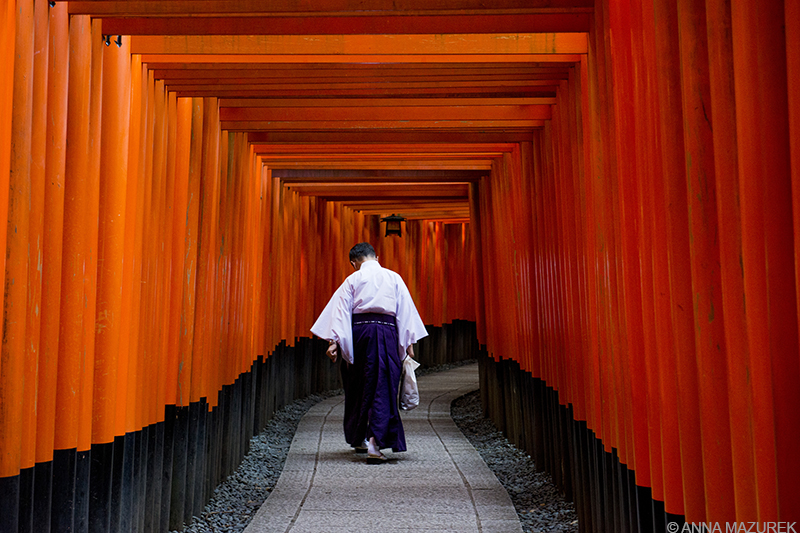
Sunrise in Kyoto
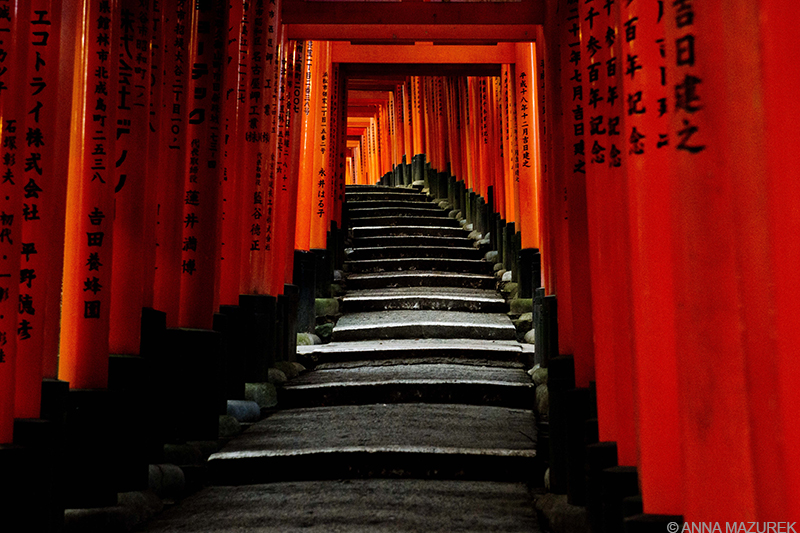
Fushimi Inari Shrine near Kyoto, Japan
Japan was not the nonchalant laid-back Asia I’d grown to love while living in Thailand. There was efficiency, guardrails and drinkable tap water. And, tour guides with megaphones.
The swarms of tourists were tainting my experience and photographs. I prayed Kyoto would redeem my image of Japan.
I had two goals on my trip—to visit my friend, Nick, and photograph the iconic red archways, known as torii gates, of the Fushimi Inari Shrine. Nick frowned. “Good luck getting photos without any people,” he said. “That place is always crowded.”
I took his warning as a challenge.
My alarm went off at 4:30 a.m. Determination masked my sleepiness. At 5:30 a.m., I was on the first train out of Kyoto Station bound for the Inari Station. The early bird gets the photo.

People write their wishes on the back of votive tablets called ema and leave them at the main temple at the base of Mount Inari. Foxes are considered the messenger for Inari, the Shinto god of rice.
The shrine was almost deserted when I arrived thirty minutes later. I walked past the main buildings toward two parallel rows of torii gates, which line the walkways of sacred Mount Inari, named after the Shinto god of rice. The two rows merged into a single row of larger gates. Each was inscribed in Japanese with names of wealthy donors. Along the path were small shrines filled with tiny gates donated by others with shallower pockets.
I wandered up the trails in search of the perfect mixture of light and composition. I did not see another foreigner for hours. A few locals emerged from the red maze on their morning walk. A woman smiled at me with curiosity under her white visor and said hello. Her outfit was as immaculate as the window mannequin of an outdoor store – a spotless jacket and ankle-length hiking pants. Later, a man wearing traditional clothing rushed past in wooden sandals. His robes swayed side to side with his stride.

There are more locals than tourists at Fushimi Inari Shrine at sunrise.
Despite the summer humidity, the locals wore long jackets and pants. Thirty mosquito bites later, I envied their clothing choices. My t-shirt and shorts offered no protection. I pulled a plastic poncho out of my bag and wrapped it around my waist like a skirt, which attracted more curious glances.
I took hundreds of photos over the next two hours. When the first tourist emerged onto the trail at 8:30 a.m., I promptly walked toward the train station. My time slot was over.
A herd of foreigners rushed off the train from Kyoto as I was boarding. I smiled, content with my new discovery. The secret to travel is getting up painfully early while the tourists and shopkeepers are still asleep. The reward is silence, photos with clean backgrounds and a glimpse of the real culture.
How to get to Fushimi Inari: Take a JR Nara Line train from Kyoto station two stops to the Fushimi Inari Station. The shrine is walking distance from the station.
__________________________________________
COMING UP:
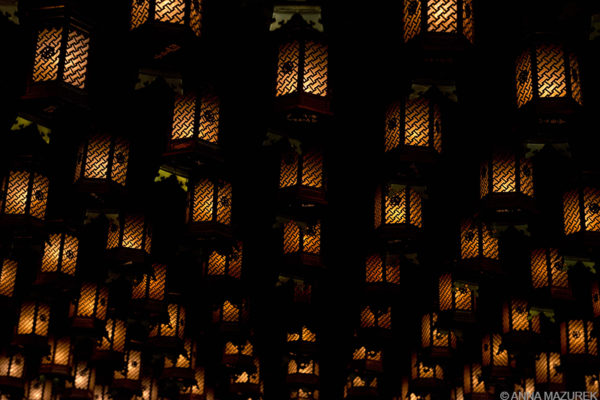
Lanterns cover the ceiling of the Henjokutsu Cave at the Daisho-in Buddhist Temple in Miyajima, Japan.
The Ultimate Guide to Japan
Next week, I’ll post an in-depth photo guide to the best places to visit in Japan complete with logistics and cost. In the next Travel Tuesday Interview, I chat with Tokyo Becky, an American expat who has lived in Japan for 10 years, about budget travel tips and off-the-beaten path destinations!
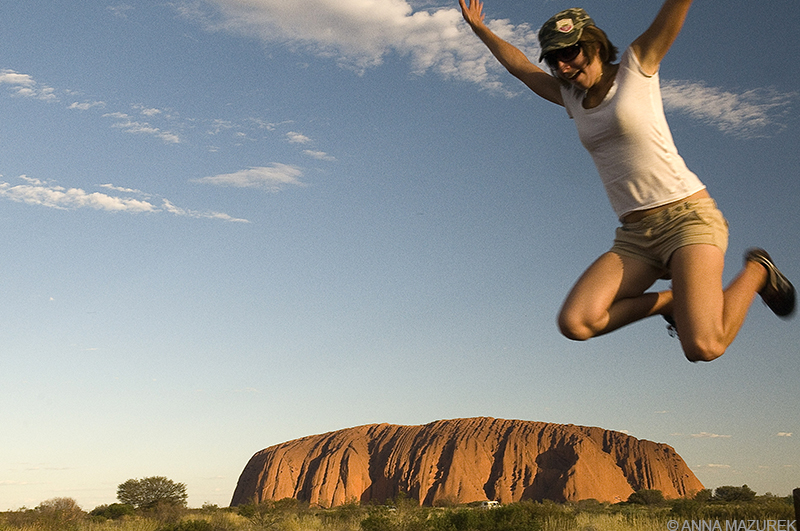
Lessons from a Year Abroad

When I lived in Sydney, I took a month off work to road/train trip through Australia and stopped at Uluru for a photo!
Let’s start the New Year off with a little travel inspiration:
In 2008, I quit everything and moved across the world. That decision changed my entire life. I recently discovered an unpublished essay I wrote for a magazine shortly after moving back to the U.S. from 13 months abroad. I was inspired reading my own essay, which made me instantly want to share it with you! Consider yourself warned: This will make you want pack your bags and buy a one way ticket!
Surviving 27: Lessons from a Year Abroad
Twenty-seven is a dangerous age. It approaches silently—cleverly hidden between the exuberant celebrations of 21 and fear of 30. The element of surprise makes it a clear turning point—the best or worst year of your life.
For famous musicians, it’s not a good year. The infamous “27 Club”—Kurt Cobain, Janice Joplin, Jimi Hendrix, Brian Jones and Jim Morrison—never saw 28. But for me, a non-musician, it was a relentless struggle that I managed to survive.
Twenty-six ended when the economy started to tumble in 2008. It became clear that recessions weren’t good for freelance photographers. I took the unconventional approach and spent a year globetrotting to ride out the economic storm.
This is where 27 stepped in like a brutally honest friend. She used her ninja skills to corner me at 4 a.m. and demanded I stop ignoring my daydreams. My old excuses were no longer valid. I already had a good education, savings and a sudden abundance of time. She tapped her foot and sternly said, “Dust off your passport. No one ever regrets spending a year traveling around the world.” She had a point. Sitting still is boring.
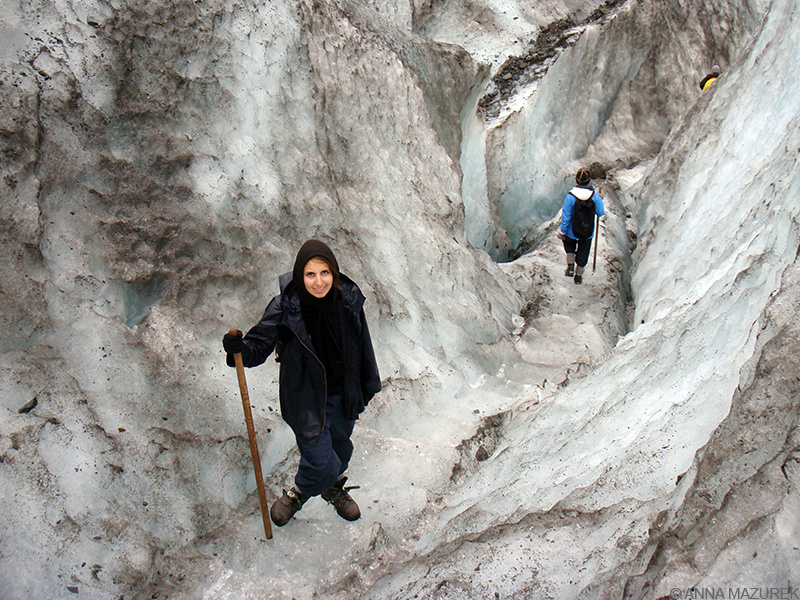
I spent a few weeks on South Island of New Zealand and went hiking on Fox Glacier, which was my first glacier hike!
I spent the next 13 months in Australia, New Zealand, Fiji and Southeast Asia. It was an amazing experience, despite the rough times and the nights spent crying on random bathroom floors. It became obvious that 27 was trying to teach me a lesson. The bad moments were all part of her plan. That year was my ultimate solo adventure—a test of courage and determination.
The first few weeks of traveling were bliss, but rocky months followed. Apartment hunting in a foreign country is a nightmare. Seriously. I admit I was tempted to call the “free internet and rice” ad out of curiosity. It was difficult to make friends in a city of four million. My initial job hunt turned me into nothing more than a professional networker. Was I crazy for moving across the world on a whim?
But, 27 had faith in me. I ended up on an airport shuttle in Fiji with four British guys who quit their jobs to travel. I wasn’t the only one. I kept meeting other people traveling for extended periods of time. Some were just out of school, and others simply quit jobs they loved to see the world. It’s a cultural phenomenon and a coming of age ritual for Europeans, Canadians and Australians to travel long term. Why is this missing from the average American mindset? I am not fearless, but I realized the things that scare me are the things I need to do the most. Maybe the people who are too scared to live their dreams are the crazy ones.
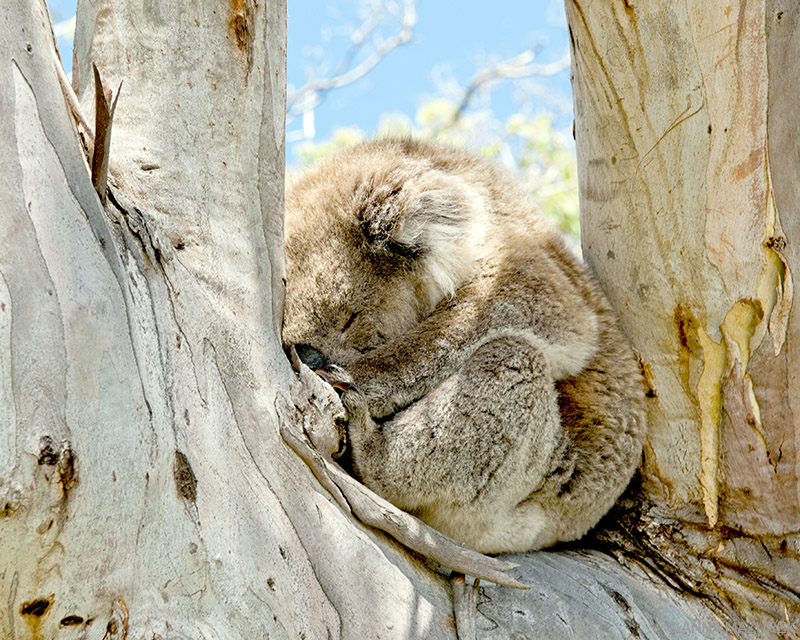
During road trip along the Great Ocean Road in Australia, we discovered some koala bears sleeping in trees along the side of the road!
Twenty-seven also gave me the chance to be 21 again. I drank cheap beer, ate peanut butter sandwiches and stayed in hostels. I spent a month road tripping around Australia with two guys from Buffalo, NY. We slept in our rental car by the beach for three days and snuck into RV parks to shower. There is nothing more exciting than living on the fringes of life. Experiences are always better investments than fancy hotel rooms and material possessions.
I scuba dived in the Great Barrier Reef, hiked glaciers in New Zealand and watched the sunrise over Angkor Wat. It is quite possible I fell in love on a Thailand beach. (I blame the rum.) I quickly found myself living in a Western Union commercial after my wallet was stolen on that same beach. (Again, I blame the rum.) There I was calling my parents at 5 a.m. to transfer me money because you can’t transfer yourself money. (Trust me, I tried EVERYTHING before calling the parents.) My adventures made me wish I spent a year after college traveling, but I don’t regret waiting a few years. I began to appreciate the freedom of 27 over the simplistic naiveté of 21.
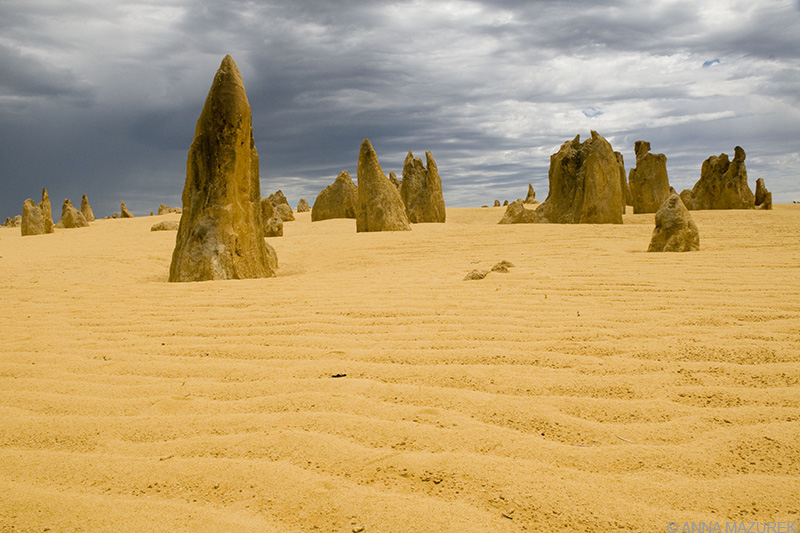
One of my favorite places in Australia was the limestone rock formations known as the Pinnacles at Nambung National Park in Western Australia. It’s totally worth the drive from Perth!
It became quite clear that moving across the world wasn’t going to erase my problems or magically improve the economy. My car was still dying. I can’t live anywhere longer than six months without getting bored. I have a panic attack every time I sign a lease. But, 27 made it clear that there is no timeline to life. I could grow up when I was ready as long as I paid my rent on time.
Traveling makes me feel completely alive. Every aspect of life overseas is exciting, even just walking down the street. The mundane becomes thrilling. Why is it that life is always clearer 5,000 miles away from home? The pressure, influences and stress of my old life were no longer in control of my actions. That is the ultimate freedom.
I counted down the days until 28. A girl can only take so many battles in a year. I said farewell to 27 with beer on a Thailand beach with some British friends. But, the lessons of 27 lingered long into 28 and made me appreciate my struggles and adventures.
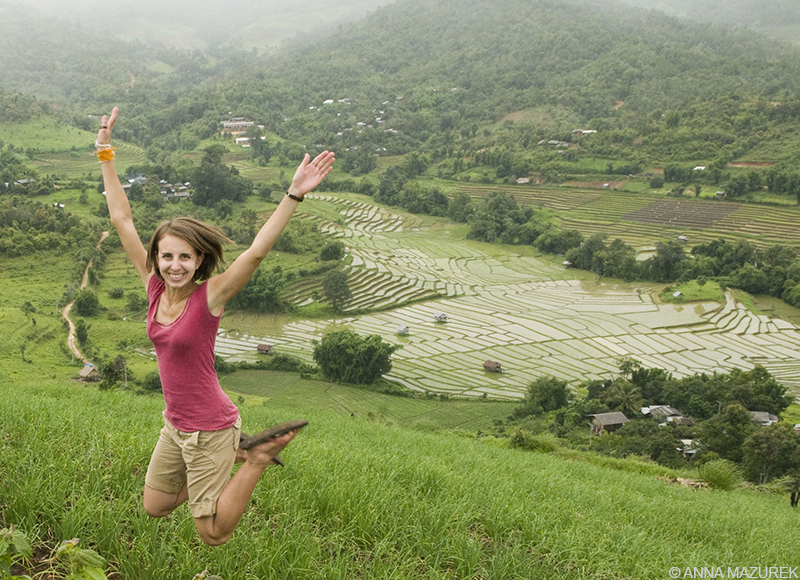
I got a job running photo trips in Southeast Asia for the summer and ended up working in Asia for the next five summers. (Photo: Rice fields in Northern Thailand)
That year stripped me down to the core and taught me about humility and patience. It was an in-depth course in world history—World War II in Australia, Cambodia’s dark past, Gandhi’s mission for peace and the plight of Burmese refugees. Four months in Asia made it clear that running water and 24-hour electricity were luxuries, not necessities.
Twenty-seven failed to warn me about coming home. Maybe she thought her job was done or that 28 would be a better teacher. Home felt foreign. I forgot about sales tax and didn’t know which way to look to cross the street. Even the accents sounded strange. After living out of a suitcase for a year, I started to de-clutter my life and shun materialism.
I began to miss Sydney Harbor, Thai pancakes and passing monks in saffron robes on the street. But, a traveler never sits still for long. The nagging sensation to spend an entire year traveling was suddenly replaced by the hunt for my next adventure. Living my daydreams began to feel normal. After surviving 27 and traveling around the world solo, anything is possible.
[I lived in Australia for a year on a Working Holiday Visa. For more about Working Holiday Visas, check out my Guide to Working Abroad.]
__________________________________________
COMING UP:
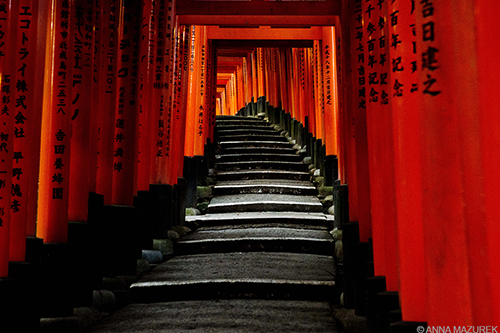
Fushimi Inari Shrine near Kyoto, Japan
The Ultimate Guide to Japan
My next post will be a photo guide to the must-see places in Japan. In the next Travel Tuesday Interview, I chat with Tokyo Becky, an American expat who has lived in Japan for 10 years, about budget travel tips and off-the-beaten path destinations!
What are your biggest Japan questions? Let me know and I’ll answer them in the next two posts!
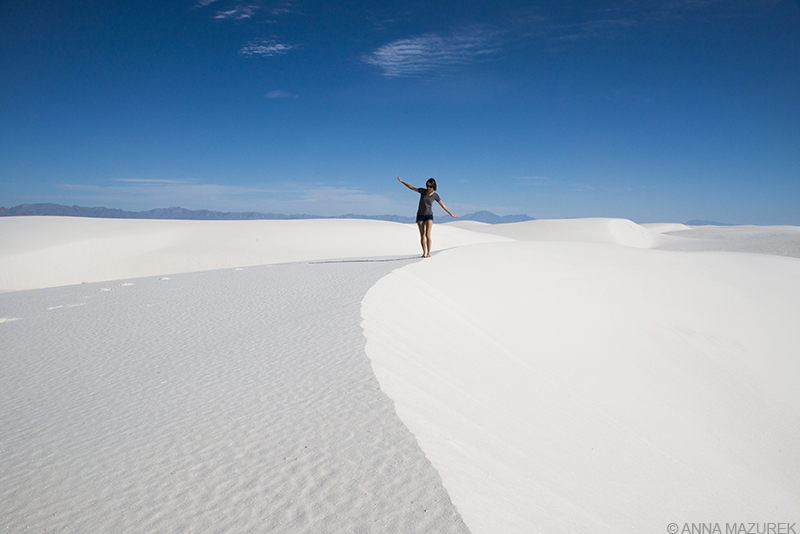
Best of 2016

White Sands National Monument, New Mexico
2016 was a never ending road trip! I started the year off exploring Nicaragua. I did a crazy 4,100-mile cross country road-trip from Texas to North Carolina via Arizona/New Mexico. During the summer, I drove the ring road around Iceland and stopped in NYC and Boston to visit friends on my way home. I finally got to see a concert at Red Rocks in Denver. I loved New Mexico so much I drove the 11-hours to Albuquerque in October for the hot air balloon festival. 2016 was not as quite crazy as last year in South America but still a good travel year. And, it’s nothing compared to what’s in store for 2017.
I wanted to wrap up the year with a recap of the five most popular posts from 2016!
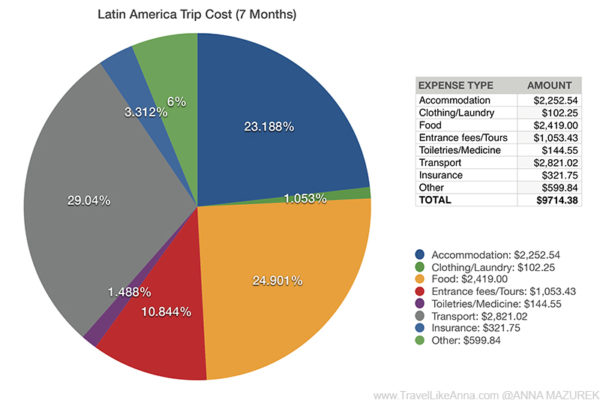
1.The REAL Cost of Travel
The greatest paradox in life is the relationship with time and money. An abundance of one leads to a shortage of the other. To prove that travel is NOT outrageously expensive, I tracked every single dollar and peso I spent on my seven-month Latin America trip. I spent hours making graphs and breaking down every single detail from postage to laundry. Check out the detailed breakdown here!
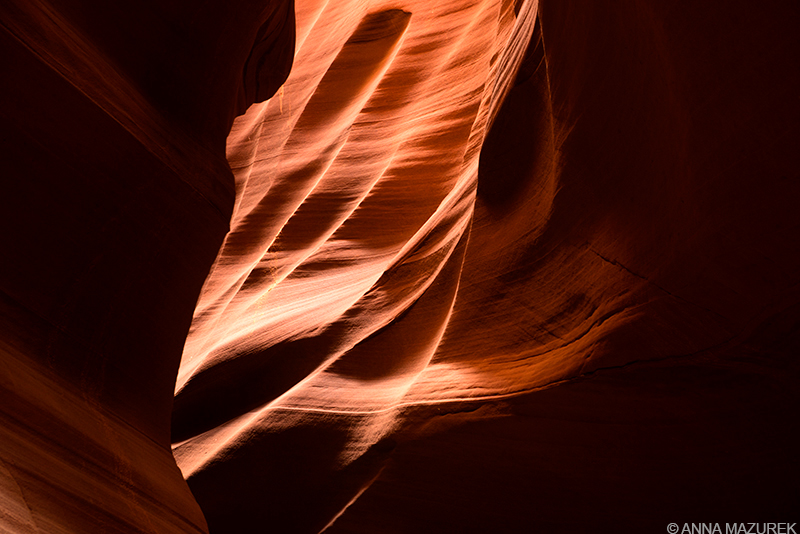
Antelope Canyon was one of the highlights of my summer road trip! For more on how to photograph the canyon, check out this post.
2. Finding the Time to Travel
Time is the second biggest obstacle keeping people from traveling. Based on my own experience and other travelers I have interviewed, I identify four main ways to work more travel into your schedule. Whether you want to carve out two weeks to road trip to Yellowstone or a year to explore Asia, here are a few ways to find the time to travel!
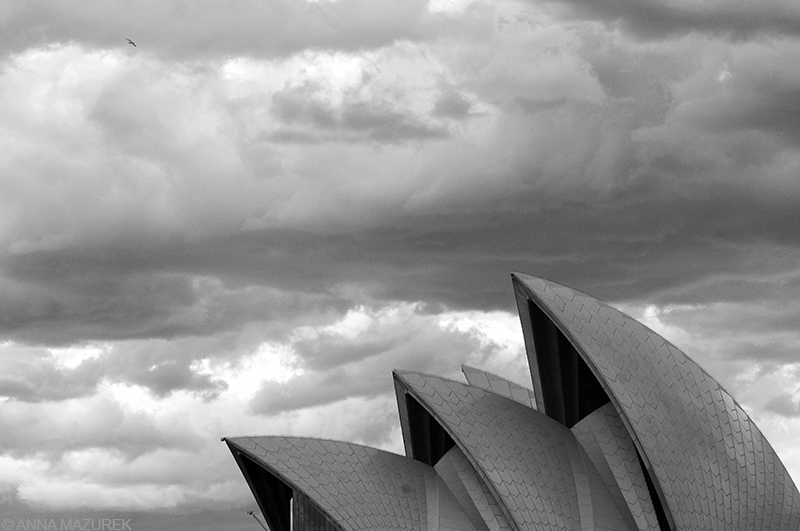
Americans under 30 can easily get one-year Working Holiday visas in Australia and New Zealand!
3. A Guide to Working Abroad
I’ve spend years researching all the ways and opportunities to work abroad. I’ve taken advantage of many – I taught English in Thailand and lived in Australia for a year on a work visa. I also managed summer photo trips for high school students in Asia. I’ve met tons of people working abroad and picked their brains about the best ways to do it.
I’ve complied my research into a simple guide about a variety of options for working abroad including links and resources. Check out the guide here: A Guide to Working Abroad
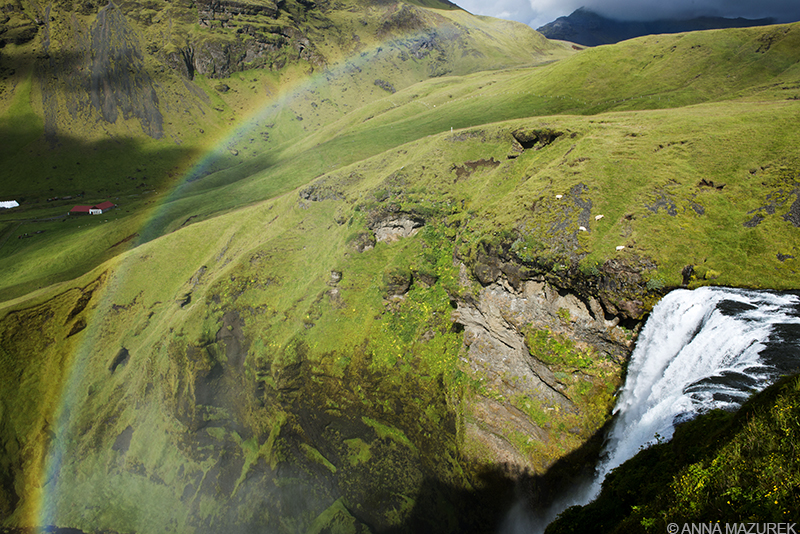
Skógafoss waterfall in Iceland is known for the rainbows created by the mist!
4. Iceland
Iceland is probably already on your bucket list. If not, then my Iceland series will move it to the top of the list! It’s by far the most beautiful place I’ve ever been. In my three-part series, I provide:
- Where to go in Iceland: A Photo Guide to Must-see Locations
- Real Cost of Iceland: A detailed breakdown of the cost of my trip and budget tips to help you plan your trip!
- Interview with an Iceland Expert: I interview an Alabama native who has lived in Iceland for the last three years about travel tips and advice.
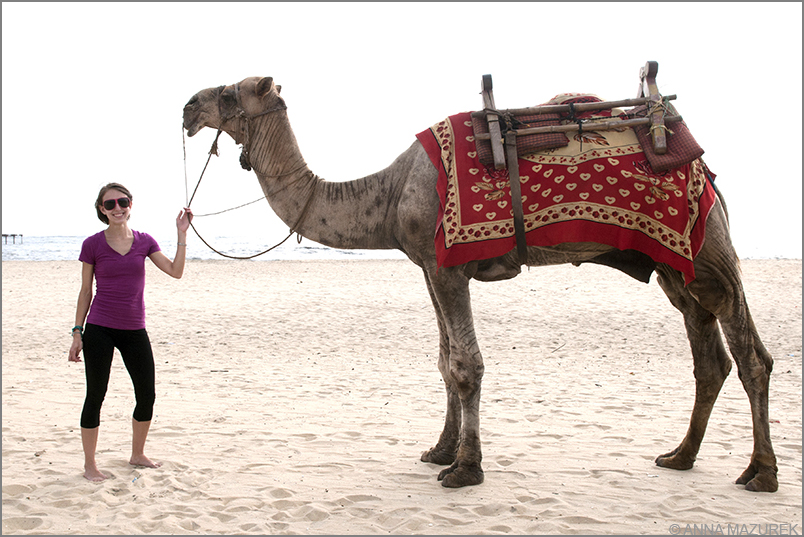
Kerala, India
5. The Myth about Travel & Luck
“You’re so lucky you get to travel.”
“I live vicariously through you!”
Last January, I wrote a short personal essay about HOW I travel as much as I do. The goal of this blog is to be completely transparent about all aspects of my travels. This is one of my most personal posts. Let me let you in on a little secret – it has nothing to do with luck. Check out The Myth about Travel & Luck!
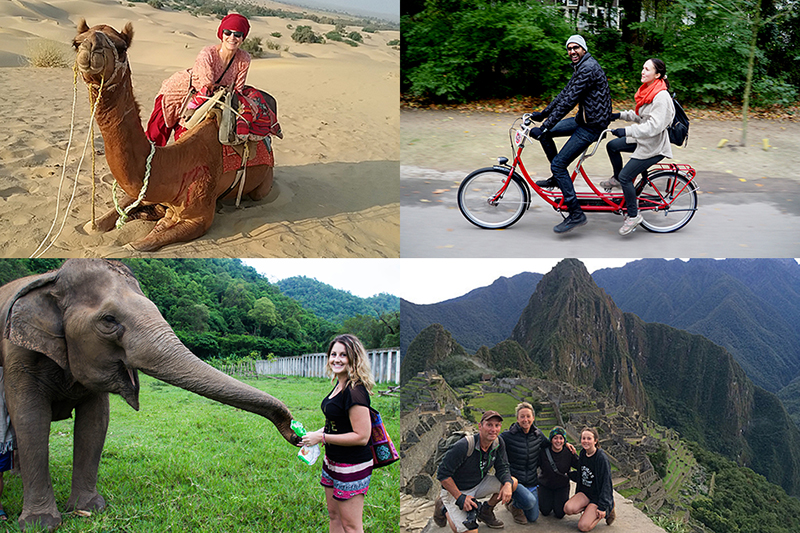
Clockwise from top left: Merrilee Davis, the traveling granny; Couchsurfing expert Nishant Prasad and his fiancé Isabelle St-Germain; McGuinness family of four who sold their house to travel for a year; and Kaleena Quarles taught English in Korea for two years to fund her RTW trip.
6. Travel Tuesday Interview Series
The best part of traveling will always be the people. I started a Travel Tuesday Interview series on TravelLikeAnna to share the inspiring stories of all the amazing people I’ve met on the road including the Traveling Granny in Colombia—a 68-year-old woman from Vancouver who has been traveling solo for years. At a hostel in Surce, Bolivia, I met a British family of four who sold their house to travel for a year. From Peace Corps volunteers to English teachers in Korea to a couple who quit their jobs to travel for a year to expert couchsurfers, I’ve met people who made travel and adventure their top priority. They have both challenged and inspired me. I hope they inspire you as well!
After all, courage is contagious.
__________________________________________
COMING UP:

Fushimi Inari Shrine near Kyoto, Japan
Japan & More
I’ll be kicking 2017 off with a travel guide for Japan along with sharing a few personal stories from my own adventures! Next week, I head to the Florida Keys for a road trip so feel free to follow along on Instagram!
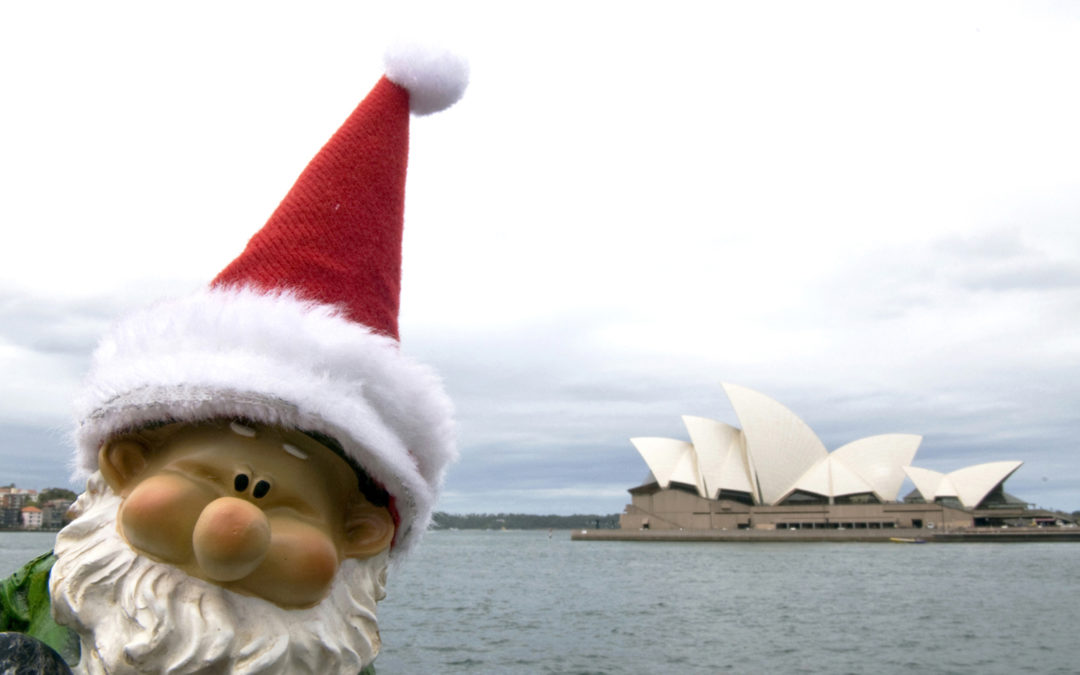
10 Great Travel Gifts
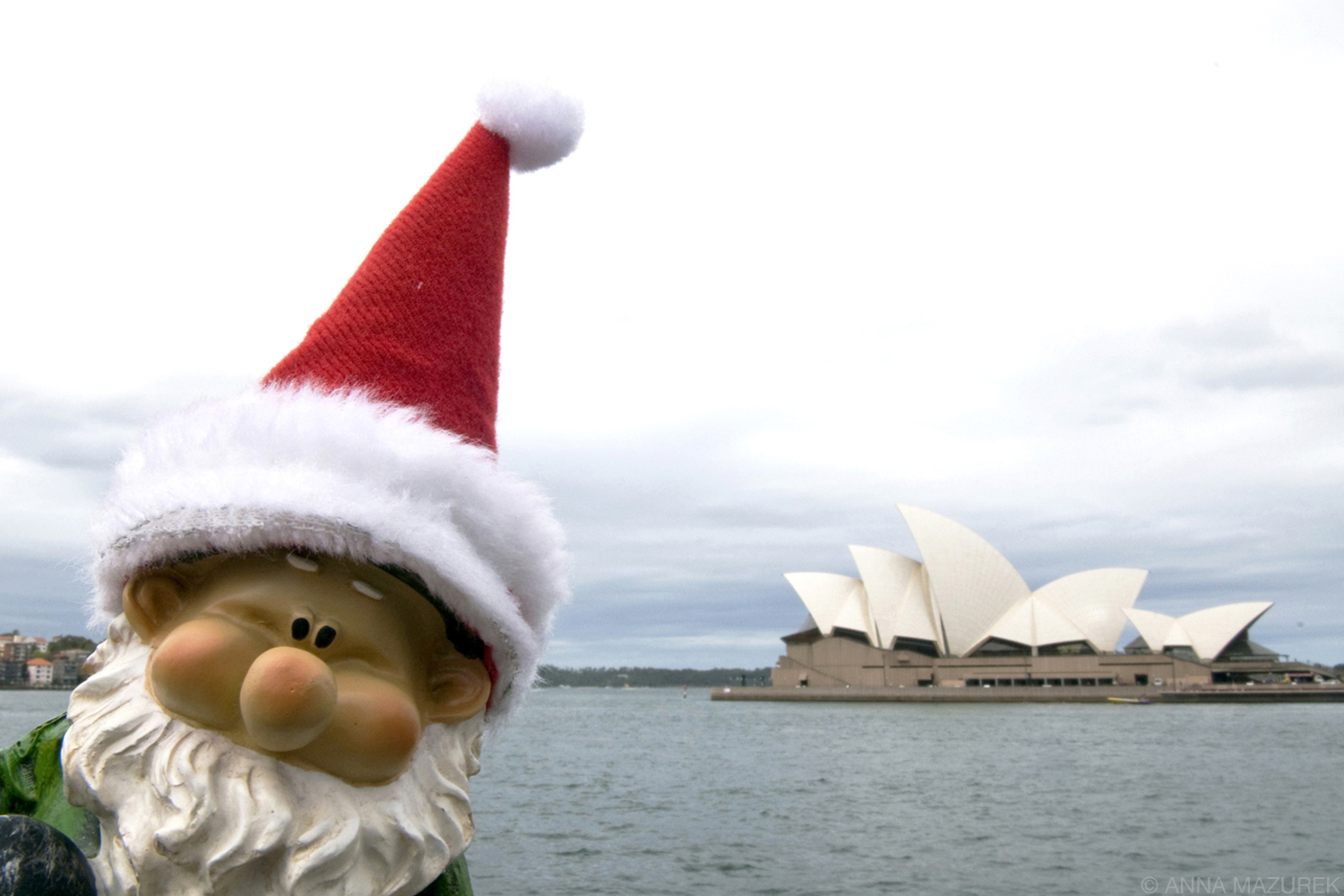
Like it or not, the holidays are creeping up on us! To help you prepare for the holiday season and your future travels, I’ve teamed up with Alfred, the globetrotting gnome, and his flamingo friend, Santiago, to share 10 useful travel gift ideas! All of these items are perfect gifts for friends/family or for you to add to your Christmas list before you send it to Santa!
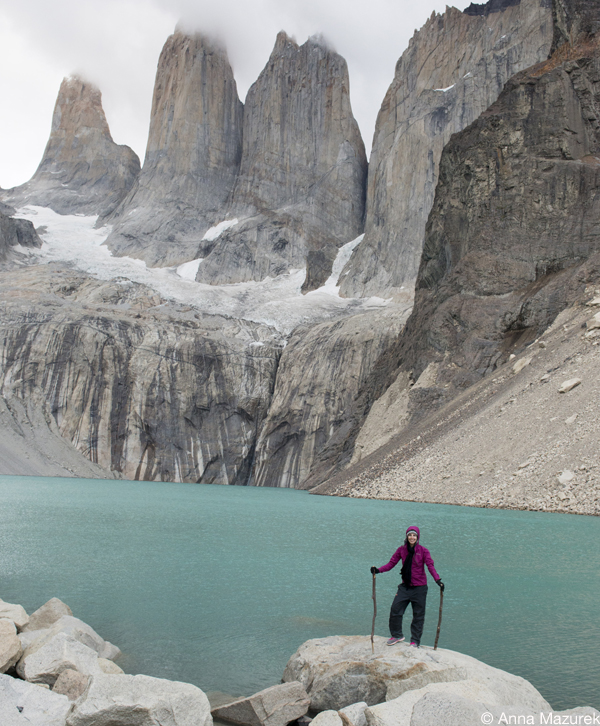
My pink Marmot rain jacket has been everywhere from Iceland to the Patagonia (above) with me. It’s a great jacket for any traveler in any type of weather!
1. Marmot Rain Jacket
The monsoon season in Asia taught me the importance of quality rain gear. There is a big difference between WATERPROOF and WATER RESISTANT. The later takes days to dry, which I learned the hard way. Luckily, I found this Marmot jacket on a clearance rack at REI. The zippered underarm vents are a life saver in the heat. It also serves as a top layer for insulation in cold weather and helps with wind.
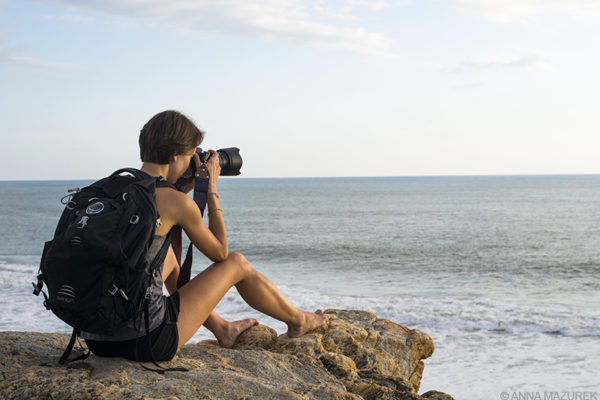
I randomly bought an Osprey backpack from an outdoor store before my first long-term trip and still use it daily!
2. Osprey Backpack
Since I am a photographer, I pack about 30 pounds of camera gear including my laptop for every trip. After a relentless search for the perfect backpack for my gear, I stumbled on this Osprey daypack that fit my shoulder camera bag and also had a laptop sleeve. It’s perfect for flying as a carryon and a great daypack for anyone!
The best thing about Osprey gear is the quality and lifetime warranty. After four trips around the world, the straps started to rip. (I’m rough on bags.) Osprey repaired it for free several times and eventually replaced it with a new one! I will never buy another brand of backpack. Don’t forget this rain cover – I often use it also cover my camera in light rain!
3. Classic Travel Books
The most important part of any trip is what you are reading. I always search for a book that both inspires to travel MORE and reminds me WHY I travel despite the delays and rough days. Beryl Markham’s West with the Night is one of my favorite books. Don’t miss these classics for any Asia trip: Paul Theroux’s The Great Railway Bazaar, The Autobiography of the Dalai Lama, Pico Iyer’s The Lady & The Monk, and Amitav Ghosh’s The Glass Palace. For Latin America, grab Graham Greene’s Our Man in Havana and Paul Theroux’s The Old Patagonian Express.
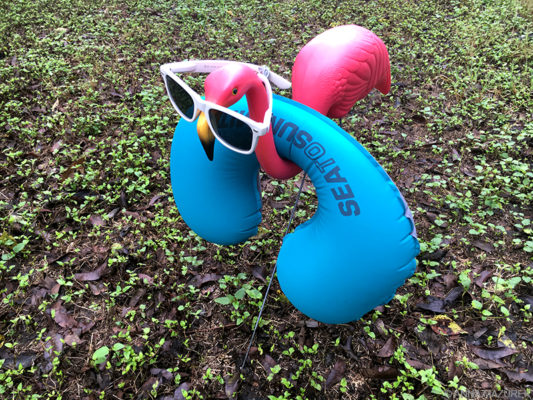
Santiago, the traveling lawn flamingo, is modeling my favorite neck pillow by Sea to Summit.
6. Sea to Summit Neck Pillow
It is entirely possible to fall in love with a pillow. I have been on the quest to find a good travel pillow for years. Foam neck pillows were too bulky, and cheap inflatable pillows don’t last. When an employee at an outdoor store recommended the Sea to Summit pillow to me, I was hesitant. Then, I took it on my trip to Iceland and was AMAZED. It was super easy to inflate with minimal effort, holds air extraordinarily well AND it packs super light.
4. Stainless Steel Water Bottle
Invest in an insulated stainless steel water bottle like Klean Kateen or YETI before your next trip. (Plastic bottles are bad for both the environment and your health.) Avoid aluminum and anything that’s not BPA free. Stainless is easy to clean (hot water) and most importantly—keeps beverages colder longer. I use this 16 oz Klean Kateen bottle every day even when I’m not traveling!
5. Sawyer Water Filter
The easiest way to save money on a trip is to pack a water filter! I recommend Sawyer’s Mini Filter. It’s tiny, inexpensive ($20) and easy to use. I used it for seven months in Central and South America. Both the filter and stainless steel bottle mentioned above will save you a fortune in airports. Simply filter the bathroom sink water. (Yes, I was THAT girl in the bathroom at the Cancun airport filtering the sink water!)
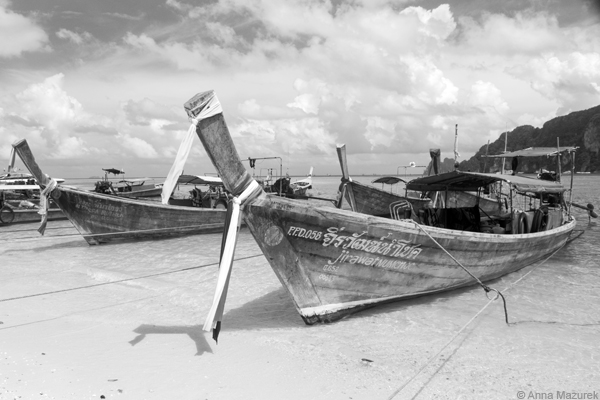
Learn from my mistakes: If you plan on taking a longboat anywhere, put everything of value in a dry bag!
8. Dry Sack
Once upon a time, I took a wooden longboat (above) to Railay Beach in Thailand. It seemed like a good idea for a 15-minute ride from Ao Naug until the boat got hit by a wave. The boat guys were using a bucket to get the water out. Luckily, my camera gear survived. The minute we hit shore I instantly invested in a dry sack like this one. Lesson learned. (Tip: Avoid these super lightweight ones for storing anything with sharp edges because they rip too easy.)
7. Swiftwick Socks
Heading to Patagonia or Nepal? Swiftwick socks are the best $12 you’ll ever spend. Since I’m a big runner, my cousin suggested I try these compression socks. Instantly, I could tell a huge difference! They are lightweight, great at controlling moisture and preventing blisters. I pack two pairs and usually hand wash them with Dr. Bronner’s soap when I travel to keep them fresh!
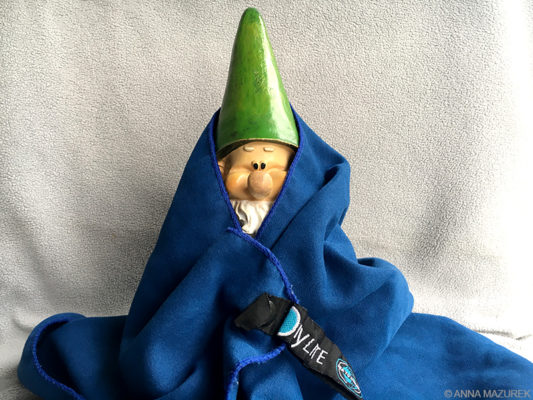
My small quick dry towel also doubles as a gnome blanket for Alfred.
9. Quick Dry Towel
Quick dry towels are the single greatest invention in life after the burrito. When I was a travel novice, I packed regular towels, which NEVER seem to dry completely. Then, one day I found a small quick dry towel on clearance at an outdoor store. It’s been the best thing ever. No more packing wet towels! This year, I plan to invest in an extra-large one during the online Black Friday sales.
10. Biodegradable Soap
Be sure to ask Santa to fill your stocking with travel sized bottles of Dr. Bronner’s peppermint soap! It’s chemical free, biodegradable and smells great. Use it as body wash, dish soap and laundry detergent. Plus, a small drop goes really far. Trust me, no other soap will make you or your clothes smell so fresh!
(Disclaimer: The product links above are Amazon affiliate links. If you click on a link and make any type of Amazon purchase, I earn a small commission at no additional cost to you. I am not affiliated with any of the brands mentioned and only recommend them based on my personal experience. To support the blog, please use this link before making your next Amazon purchase to help TravelLikeAnna.com to continue to grow and provide meaningful content!)
__________________________________________
COMING UP:
Where to Go in Southeast Asia
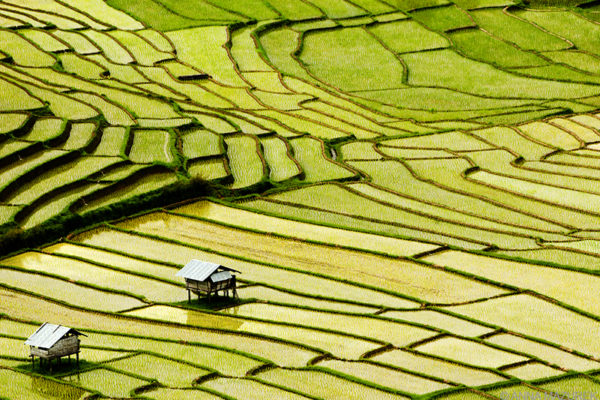
Bon Mai village, Thailand
I’ll start wrapping up 2016 with a series on Southeast Asia, where I lived and worked for three summers. First, I’ll cover where to go in Southeast Asia followed by a detailed guide for Thailand! What do you want to know about Southeast Asia?
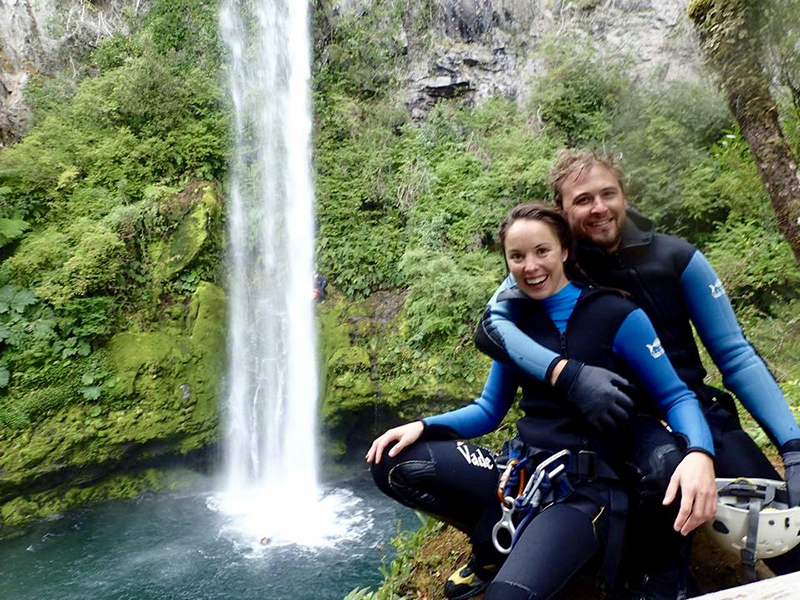
Meet a Couple Who Quit Their Jobs to Travel for a Year
 To recover from trekking in Patagonia, I spent a week in El Bolson, a small village south of Bariloche, Argentina where I met Marita Jansons and Matt Butt. The Australia couple was just starting a year-long round-the-world trip! We became instant friends and ended up traveling in Bolivia together for a few weeks. In this Travel Tuesday Interview, Marita shares all the details about their trip including quitting their jobs as a teacher and a lawyer, their budget and her favorite recipes to cook on the road!
To recover from trekking in Patagonia, I spent a week in El Bolson, a small village south of Bariloche, Argentina where I met Marita Jansons and Matt Butt. The Australia couple was just starting a year-long round-the-world trip! We became instant friends and ended up traveling in Bolivia together for a few weeks. In this Travel Tuesday Interview, Marita shares all the details about their trip including quitting their jobs as a teacher and a lawyer, their budget and her favorite recipes to cook on the road!

Marita Jansons, a teacher, and Matt Butt, a lawyer, both quit their jobs to travel for a year in 2015 and don’t regret anything.
Name & Age: Marita Jansons (age 29) & Matthew Butt (age 31)
Hometown: Sunny Sydney, Australia
Country Count: Between us we’ve been to 40 countries. In 2015, we hit-up 19!
1. What made you quit your jobs to travel for a year?
Ultimately, our trip was our delayed ‘gap year.’ Matt has always wanted to tick extended travel off his bucket list. I took some convincing. When it got to the point of Matt purchasing non-refundable, one-way tickets to Argentina, I knew he was serious!
We were also planning a wedding and discovered that weddings are EXPENSIVE! We figured we could get three to six months of travel out of the cost of one day. The wedding could wait!
For Matt, it was never a question. He wanted to go — job or no job. I was really nervous about the prospect of traveling for a year. I was in stable employment [as a teacher] and was convinced that I would need to quit to be able to travel. I had strong roots with my employer and enjoyed my job. When experiencing a particularly significant moment of inner turmoil, I realized that I couldn’t see myself as someone in my final stretch in the race of life saying, ‘One of the best choices I made was staying in my stable job and not seeing the world!’ From that moment onwards, it wasn’t a question, and I threw myself into planning alongside Matt. With all of that said, my employer kindly offered me a year’s sabbatical leave. Would I still have gone had they not? Absolutely!
Matt was offered his same job [at a corporate law firm] when he returned to Sydney but chose to explore other opportunities away from corporate law. He is now working as in-house council for a large Australian company and thoroughly enjoying a better work-life balance.
Since returning (and through our journey) many people have said “I wish I could do what you have done,” usually accompanied by a look of gloom and longing.
We met long-term travelers with mortgages, toddlers, and teenagers; people who had just lost their job/started a new job; those who had sold all they owned, and not one of them had any regrets! Yes, some sacrifices are made. For us, with a little prior planning, the experience far outweighed the forgoes. You only live once, why not dive in head first?!
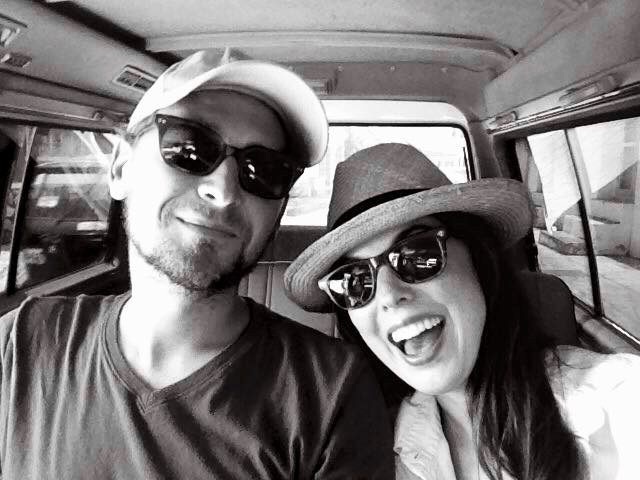
The couple snapped this photo en route to Tikal in Guatemala on Matt’s birthday.
2. Tell us about your year of traveling in 2015.
Our initial grand-plan was to tackle the world. Starting in Latin America, moving onto Europe, before finally finishing in Southeast Asia. In the end, we hit South America and knew we would end up settling in the area for some time. We were hooked by the flavors, sights, scents, sounds and overall passion of the Latino wonderland.
Europe was scrapped. We discovered that slow travel was our groove – the thought of covering the vast amount of land, sea and air we initially planned was not our travel style, at least for this trip. We finished in Southeast Asia exploring Sri Lanka and spending much time underwater diving in Thailand and the Philippines.
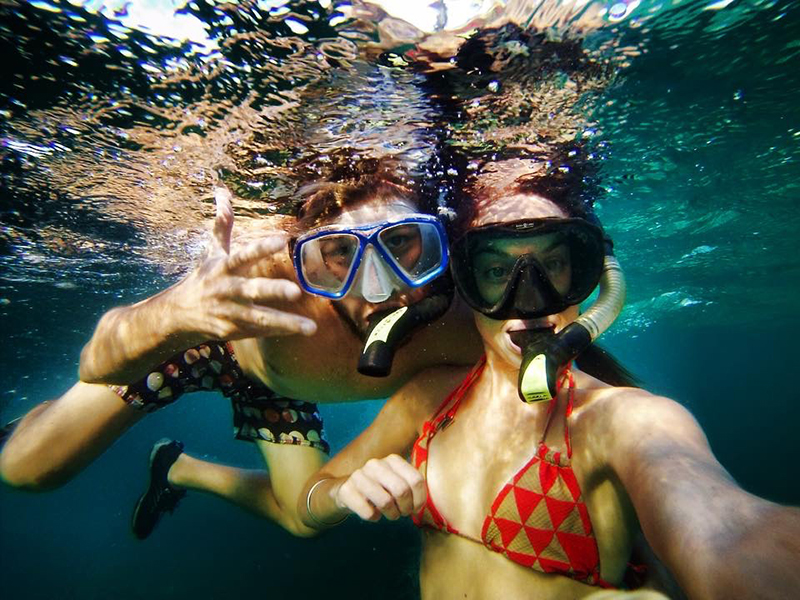
Matt and Marita ended their trip snorkeling and diving in the Philippines before heading home to Sydney, Australia.
3. How far in advance did you start planning/saving for your trip?
We saved for about two years, take-it-or-leave-it. We selected a starting point, booked tickets and mapped out our first two weeks of travel, nothing more. With that said, there were a couple of points where we booked an ‘unmissable experience’ a few weeks in advance as we approached our destination. The reason being, that a few of these trips often book out in advance for example, a sailing trip in the Galapagos or the Inca Trail in Peru (which books out some months ahead). Traveling with a ‘flexible style’ takes some getting used to and planning on the go can be grueling, but for long term travel the pros far outweigh the cons.
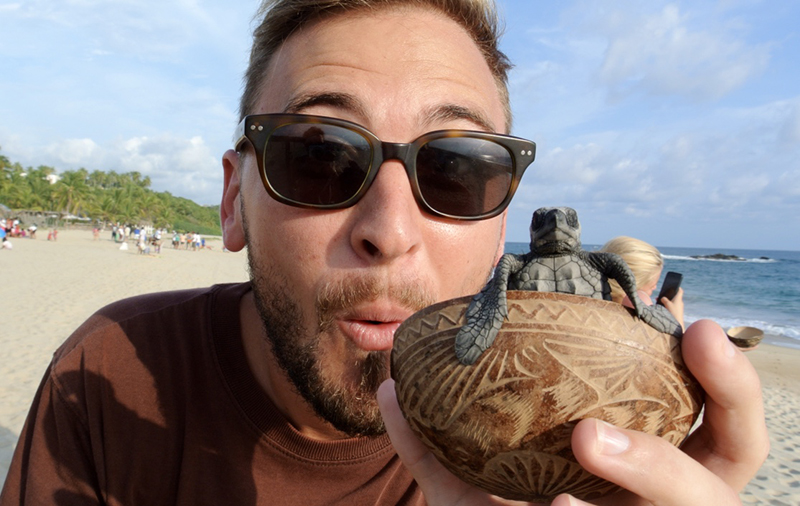
Matt helped release a baby turtle in the ocean in Puerto Escondido, Mexico. He and his fiancé’s budget philosophy was simple – never miss out on something you want to do just to stay on the road longer.
4. What was your daily budget?
Backpacker, flashpacker or cashpacker? We definitely fell into more of a flashpacker category, splitting our time between hostels, hotels and B&Bs. After some time of budget travel, we would give ourselves the opportunity to splash out for a week and enjoy our own space.
When averaged out over the whole trip, our daily spend was about $230 AUS ($174 USD) for the two of us, including all travel and pre-travel expenses (flights, travel gear, insurance, etc.). This was perhaps higher than most travelers we met, due to the fact that we were keen on some more expensive experiences, for example sailing in the Galapagos for 10 days, which was quite pricey. Our main rule was to never miss a desired experience in the aim of simply extending our length of travel – we felt that it would be awful for us to have returned home only wishing we ‘woulda, coulda, shoulda,’ and even if this meant an early return, we were willing to make that sacrifice.
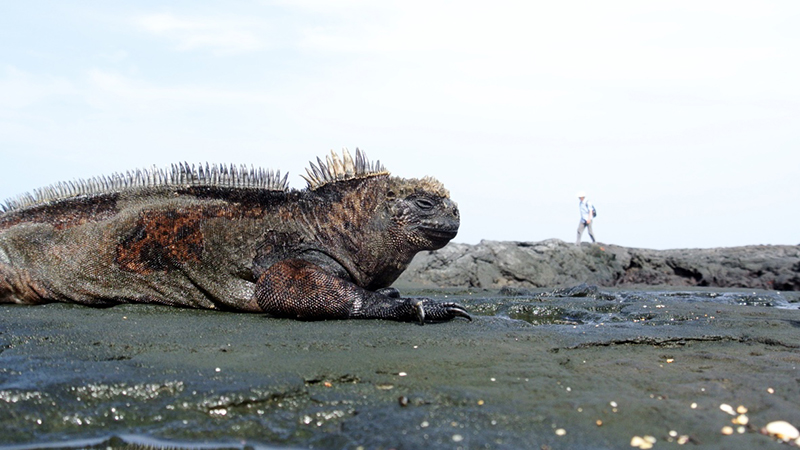
The couple splurged on a 10-day trip to the Galapagos, which was one of the highlights of their trip.
5. Share one of your travel highlights.
Our list of highlights is extensive. We found the more we traveled, the more our bucket list grew. Being difficult to cut highlights down to only one, here is a quick list of some of our top picks:
- Learning a new language was challenging and enriching, and absolutely enhanced our travel experiences
- Getting up close and personal with the friendly fauna of the Galapagos. In fact, just meeting and swimming with loads to exciting animals including whale sharks, manatees, thresher sharks, turtles, penguins, fur seals, sea lions, marine iguanas… the list goes on!
- Hiking in Patagonia in El Caltén, Argentina
- The three-day overland border crossing from Chile to Bolivia – with the one and only ‘Travel Like Anna’!
- The rich culture of Colombia, dancing salsa in Havana, Cuba and absolutely everything about Mexico!
- Getting out of our comfort zone and facing fears. We learnt to scuba dive, went canyoning and even tried something called hydro-speed (look it up)!
6. What was your greatest struggle during the trip and how did you overcome it?
Giving ourselves permission to stop. Travel can become tiring and around the six month mark we experienced a little ‘planning burnout’ (i.e. drifting without plans, and not making the most of where we were). We gave ourselves time to stop for a week here-or-there; but, in hindsight, stopping for a few weeks with prior planning and purpose could have been more useful. Though, our need to rest did lead us to some extraordinary locations including a hut in the Panamanian Jungle. Throughout the year, we discovered we were never in one place of accommodation for longer than one week!
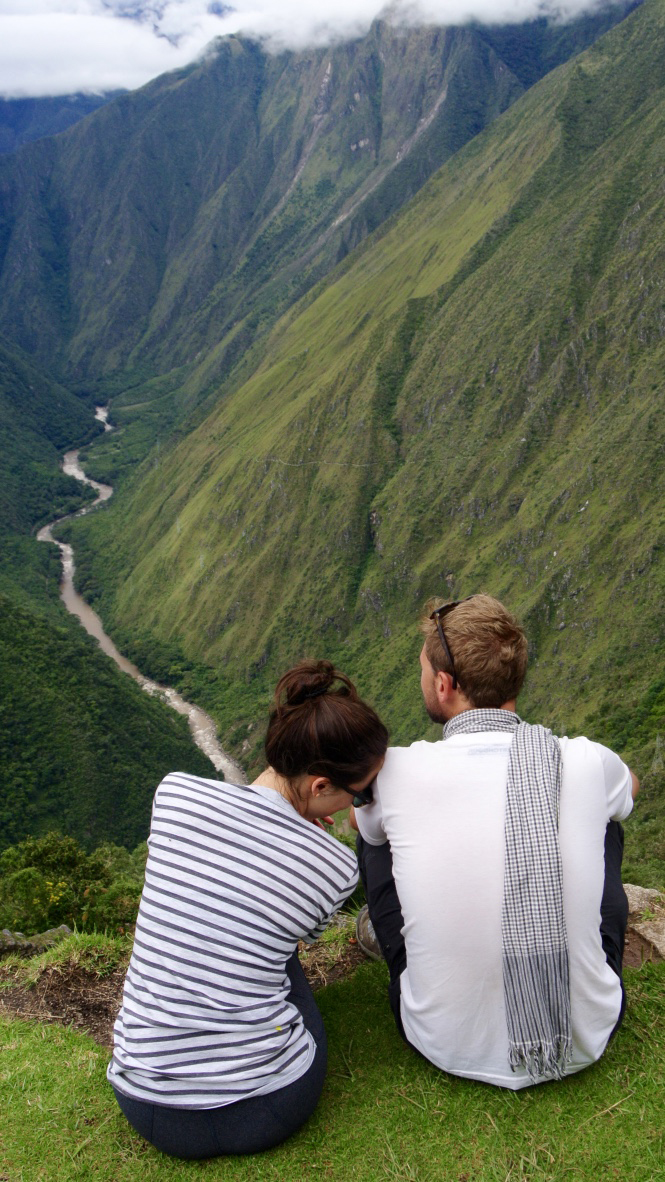
Marita and Matt stop to rest while hiking the Inca Trail to Machu Picchu in Peru.
7. What advice would you have for couples aspiring to travel together?
Patience, compromise and understanding is an absolute must. We hit our 10-year anniversary in 2015 and even after all those years we still found being together 24/7 challenging at times. With that said, travelling together has made us a stronger couple. Our respect for each other has grown – respect for our strengths and our weaknesses. We shared the dizzying highs and supported each other through the lows. You learn how to balance each other; when one of us needed to take a backseat, the other took charge for the day. Our year changed us as individuals and allowed us to grow as a couple with such a strong desire to continue sharing new experiences together.
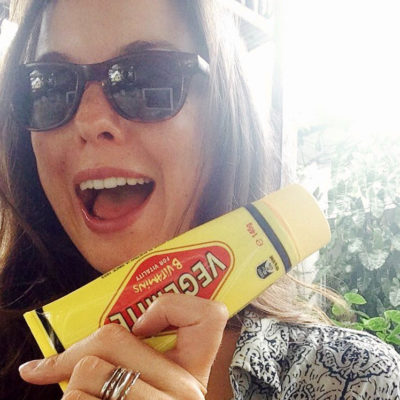
Marita’s packing tip: Don’t forget to pack your Vegemite! (Or any other food from home the you love!)
8. Name three things to pack for a long-term trip
This is a hard question! There are the obvious answers such as a decent backpack, inner sheets, good waterproof shoes, a small wind/waterproof shell, multi-purpose layers etc. However, these tend to be mentioned regularly on travel blogs. So we’ve tried to narrow it down to items we found EXTREMELY useful but which are not always first thought of:
- Packing cubes!!! These babies are a genius way of organizing and maximizing space in your bag. These packing cubes found on Amazon are similar to the ones we used. I used three slim and one small cube while Matt preferred larger cubes.
- Extra/back-up banking cards. We had a few occasions/countries where the ATM cards from our international bank wouldn’t work – thanks Peru! We were lucky to have back-up cards from our Australian banks to save the day (go figure), even if we did encounter delays as a result.
- Vegemite! (Or any nostalgic food item not available outside of your home country). Being Australian, we grew up on Vegemite. Thinking it a little excessive, we actually didn’t pack any at the start of the trip. BIG MISTAKE! I got to the point of considering having it shipped to a location in Chile. We ended up meeting some lovely Australians heading home, who donated their stock of Veg. Not only was this a nice reminder of home, it was also a great conversation starter!
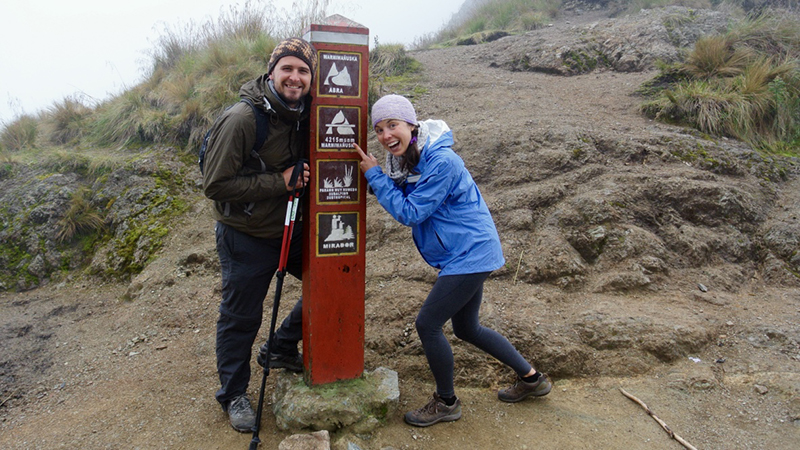
Matt and Marita packed a versatile amount of jackets and layers for all their hiking plans and used packing cubes to make sure everything fit in their backpacks. (Dead Women’s Pass, Inca Trail, Peru)
9. Marita, you are the quite the chef. Can you share some tips for cooking while traveling?
Keep it simple. You don’t have the luxury of stocking a fridge or having complicated cooking equipment on hand, so start with a few key ingredients and build from there. Some things that helped us along the way:
- A small air-tight container is a great way to store a few key ingredients to jazz up a meal. Generally, we carried some garlic (an easy way to add depth to your curry or pasta sauce), stock cubes (adds quick flavor to numerous dishes and stores easily), a small jar of cinnamon, dried chili flakes, red curry paste (when we could get our hands on some), honey and peanut butter.
- Become familiar with items stocked in hostel kitchens. Some kitchens are fantastic with herbs and spices; others, you’ll be lucky if someone has left a can of pickled eels from 1978. Usually, you’ll be able to get your hands on communal cooking oil, salt and pepper. There will also often be some rice and pasta on hand.
- Hit up the local farmers’ markets – not only are they an amazing cultural experience you can also get your hands on beautiful fresh produce.
- Eating with new acquaintances is a great way to share cost and make new friends!
Two of our favorite recipes we used are outlined below:

These three-ingredient banana pancakes were AMAZING. This is a picturesque batch Marita made when we were in Bolivia!
Easy-Peasy Gluten-Free Banana Pancakes (Serves 2)
| Hostel Kitchen | From our Container | From the Market |
| 1 tbsp. Cooking Oil | Cinnamon Honey to serve |
2 medium ripe bananas 4 large eggs |
Mash the bananas. Mix in the eggs and cinnamon. Cook these lovelies on a low heat for a little longer than you would flour-based pancakes. There is a great overview of the recipe here. I made my pancakes a little larger than recommended in the link, cooking them slower on a lower heat, this way issues with flipping were reduced.
Pumpkin and Chickpea Curry (Serves 2)
| Hostel Kitchen | From our Container | From the Market |
| 1 tbsp. Cooking Oil Steamed rice to serve |
2 cloves of garlic, finely sliced 2 tbsp. red curry paste 1 cup (250ml) vegetable or chicken stock |
400g can of chickpeas 400ml coconut milk 600g pumpkin, pealed and chopped* 1 eggplant (aubergine), pealed and chopped* lime wedges to serve (if available) |
*Dish can be made with other similar vegetables (carrots, potato etc.) depending on availability.
Heat oil in saucepan over a medium-high heat. Add garlic and curry paste and cook until fragrant. Add chickpeas, pumpkin, eggplant, coconut milk and stock to pot. Simmer until pumpkin is soft. Serve with steamed rice and lime wedge.
10. What is your next adventure?
We really enjoyed our time in the Philippines and are thinking of returning and traveling through some areas we didn’t have the chance to explore. We’re also finally planning our wedding!. [They are getting married in January with a honeymoon in Fiji to do some diving!]
__________________________________________
COMING UP:
Holiday Gift Guide: 10 Great Travel Gifts
Like it or not, the holidays are creeping up on us! To help you prepare for the season and your future travels, I will share 10 great gift ideas for friends and for you to pass on to Santa for your Christmas list!
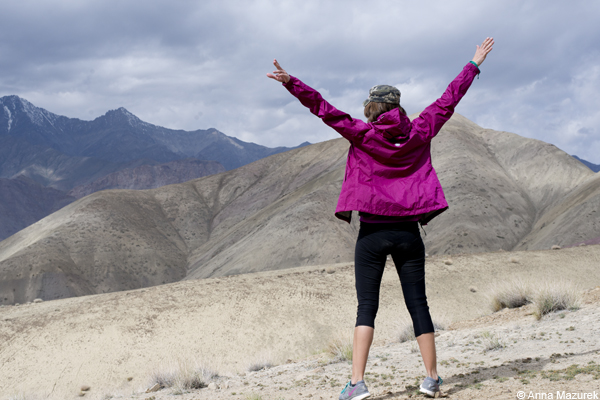
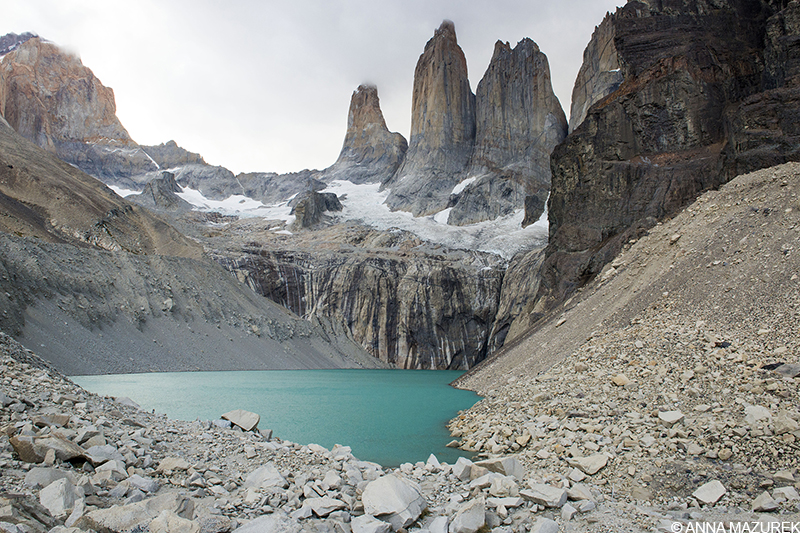
How to Find the Time to Travel

The view of the towers at Torres del Paine in Chile was one of my favorite moments from my travels last year.
The great paradox of life is the relationship between time and money. An abundance of one usually leads to a shortage of the other.
I’ve talked about money in previous posts – saving for travel, eliminating your bills and Travel Banking 101. I’ve also written about the REAL cost of travel, where I broke down the entire cost of my seven-month Latin America adventure.
Now, let’s chat about TIME. Whether you want to carve out two weeks to road trip to Yellowstone or a year to explore Asia, here are a few ways to find the time:
Make the Time
My non-stop traveling has nothing to do with luck. I travel constantly because I MAKE the time. If I want to do something, I do it. It might take months or years. Regardless, I make it happen. The idea to travel long-term in South America crept into my brain in India. After a year and a half of relentless planning and saving, my bags were packed. During my trip, I met other travelers who carved time for travel into their lives like the 68-year-old solo Traveling Granny and Rob and Cath McGuinness, who traveled around the world with their teenage daughters for almost a year!
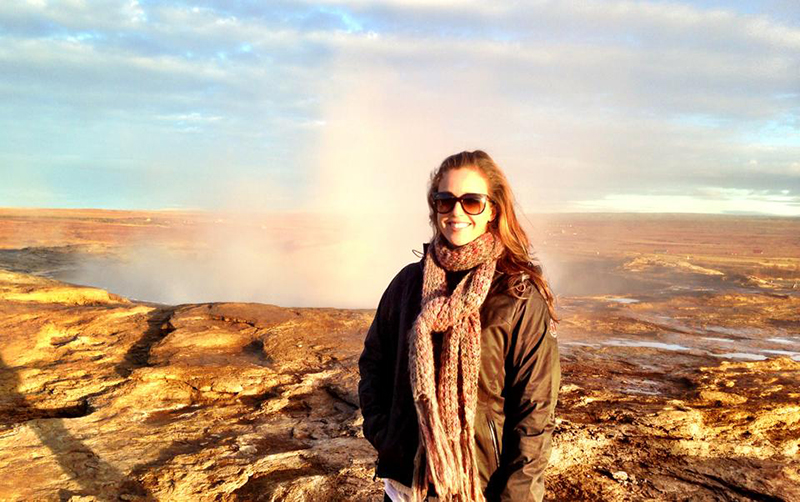
Michelle Sinclair organizes her work schedule around her travels to take advantage of low season prices in places like Iceland.
After graduate school, I quickly realized my $10/hour internship was not enough to live on. I promptly found a bar job—a job I truly loved that also helped fund my travels for a good five years. The best part of working in the bar world was the amazing people I met like my friend Michelle. She’s a bartender in Birmingham, Alabama who arranges her entire life around her travels. After a cost-value analysis, she realized that she made 80% of her income on Thursday through Saturday nights. She only works those nights to allow her to spend the rest of the week in Iceland, Europe or hiking Zion. While she is limited to shorter trips, it allows her to both keep her job, which provides a really good income, and still travel.
Negotiate the Time/Work Remotely
Never underestimate the power of strong negotiating skills. The biggest secret to budget travel is to take advantage of business trips. Tack on a few days to the beginning or end of every trip to explore nearby places. Since your initial transport is covered, your expenses drop tremendously.
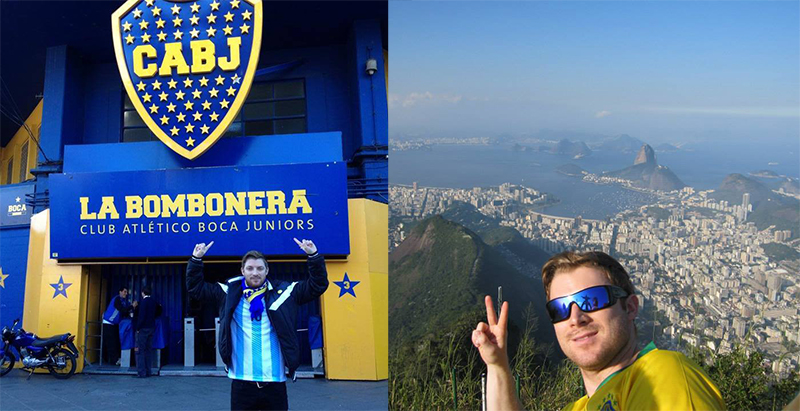
My friend Steve negotiated an extra long vacation for 2014 World Cup. Left: Buenos Aires, Argentina. Right: Rio, Brazil.
Sometimes, a few days isn’t enough time. My British friend, Steve, was determined to go to the 2014 World Cup in Brazil and travel in South America. Since he was living in Australia on a work visa sponsored by his commercial real estate job, quitting wasn’t an option. Instead, he went to his boss a year in advance and asked for two months off work, which is double his normal vacation time. In exchange, he offered to take on extra work projects beforehand. Guess what? His boss said yes!
Let’s be honest – the world is transitioning to a remote workforce. Many jobs already allow employees to work from home one day a week or even more. Why can’t you transition one day a week to weeks or months? Here’s a few great resources: Remote Year, a program that allows professionals to live in a different city each month and still KEEP their jobs. AFAR also has a great article on ways to find great co-working spaces.
Whether you want four weeks to go on tour with your band, three weeks to go to Italy for your anniversary or to work remotely from Australia for a year, there is a way to make it happen. The trick to negotiating is timing, tack and planning. The odds are that if you go to your boss in advance with your plan and have solutions for all possible objections, then you can find a way to make it happen.
Take Advantage of Time Gaps
In between travels, I teach part-time at Texas State University and spend one class period each semester stressing the importance of travel to my students and how to travel on a budget. After all, there’s no better time to travel than summer breaks and after graduation!
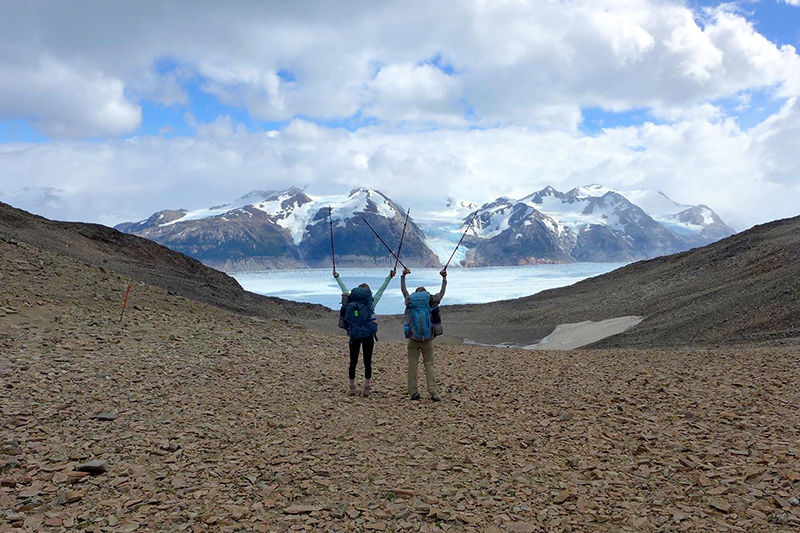
The Lacksen sister’s are a year apart in age but still managed to coordinate their long-term graduation trip together.
On a bus in Patagonia last February, I met two sisters from Georgia – Katherine and Elizabeth Lacksen. They planned an epic joint-graduation trip after college: six months in Latin America. The idea started brewing long before they booked their flights. When Elizabeth graduated six months early, they jumped at the chance to travel together and packed their bags. (Read my Travel Tuesday Interview with the Lacksen sisters!)
Aside from graduation, I’ve met people who took advantage of other gaps of time (ranging from weeks to months) to travel when they changed jobs. I met other folks who got laid-off from their jobs and decided to use the abundance of time they were given to travel. It’s the best way to turn a negative situation into a positive one!
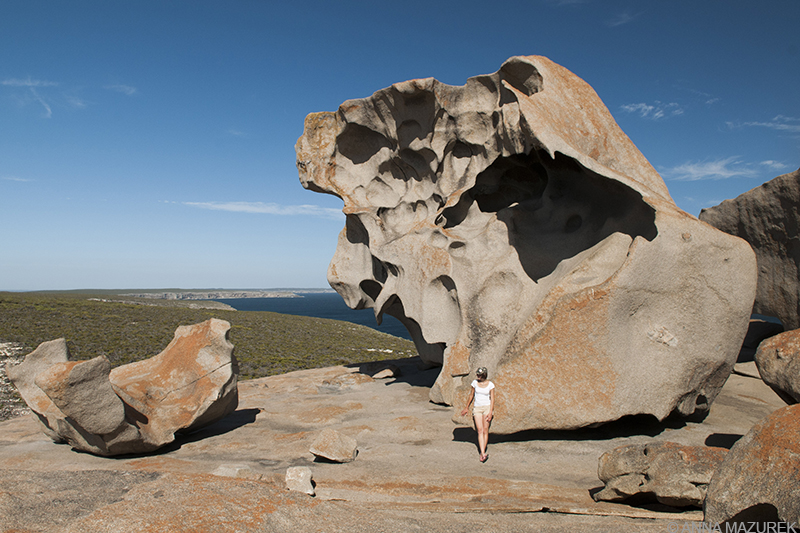
When I lived in Australia, I spent a month traveling around the country and spent a few days on Kangaroo Island southwest of Adelaide.
Quit Your Job
I remember sitting in a conference room with my sweaty palms. It was 2008. My resignation letter was neatly folded in my purse. I was quitting my first “real” job to travel.
After I told my editor about my plans to move to Australia, he instantly said he was jealous. That’s right – my boss was JEALOUS!
I had daydreamed about Australia for almost a year. But, my career took off and paused my dream. As the economy started sink, Australia creeped back in to my head. Recessions aren’t good for freelance photographers. I knew had to go. That 13-month trip changed everything. In hindsight, the recession was a cleverly disguised opportunity to start living my daydreams and travel for a living.
My seven-month Latin America trip last year was equally life altering. That trip put me on the radar of some big magazines that I spent years trying to get my foot in the door. The more you do the things you love, the more the world starts to notice.
Was it scary to quit? Yes. Do I regret a single minute? Nope. I have been hired back (in some capacity) by every single job I have ever quit to travel!
The best part is that I am NOT the only one who’s ever quit their job to travel. Everywhere I go, I cross paths with other travelers of all nationalities that did exactly the same.
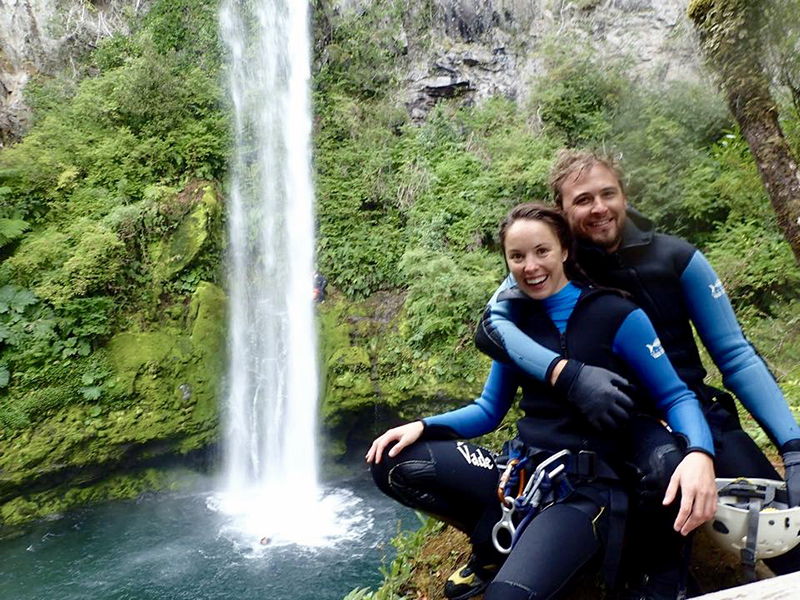
Martia and Matt quit their jobs to travel for an entire year and stopped in Puerto Varas, Chile to go canyoning.
At a hostel in Argentina, I bumped into an Australia couple (a lawyer and teacher) who quit their jobs to do a year-long around-the-world trip. (We ended up traveling together for almost a month in Bolivia!) When Marita quit her teaching job that she loved, her boss instantly offered to give her a one-year sabbatical so she didn’t have to quit! (Check out my Travel Tuesday Interview with Marita and Matt!)
On a local bus in Peru, I met a 27-year-old guy from Denver who quit his high-paying sales job at a start-up to travel for several months. He did the same thing a few years before to travel in Europe. The best part is that it didn’t hurt his career. He’s now working in the same field for his dream company!
Let’s be clear. Finding the time to travel might not be easy. Nothing worthwhile will ever be easy. There will be sacrifice, but it is always worth it. When you’re 80, you’ll NEVER say, “Man, I totally regret that year I spent traveling around Australia.”
You no longer have any excuses. Make the time, book a flight and go make me proud! 🙂
_______________________________________
COMING UP:
TRAVEL TUESDAY INTERVIEW: Globetrotting Lacksen Sisters
In the next Travel Tuesday Interview, I talk with Elizabeth and Katherine Lacksen. The two sisters coordinated their college graduation trips together and spent six months traveling in Latin America!
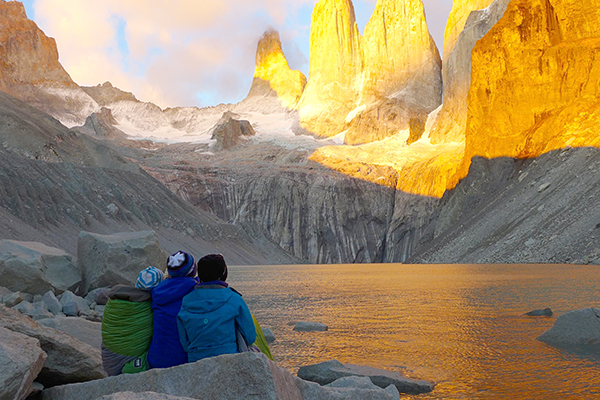

The Real Cost of Iceland: Budget & Packing Tips

The rainbow view from the top of Skógafoss waterfall is worth the climb up the steep staircase.
How do I afford to travel so much? I’ve written about how I save money and eliminate my bills. I started tracking my spending on my 7-month Latin America trip and wrote a long post about the trip. I believe in full transparency. Travel is cheaper than you think.
I avoided Iceland for a long time do to the cost. I was convinced that it would be the most expensive trip of my life, but I spent surprisingly less than I thought. I did stay with friends a majority of the time, camped and slept in my rental car. I realize this skews my budget a bit. I’ve included the normal cost of accommodation below to help you budget for your own trip. Here is a breakdown of the cost of my trip to Iceland:
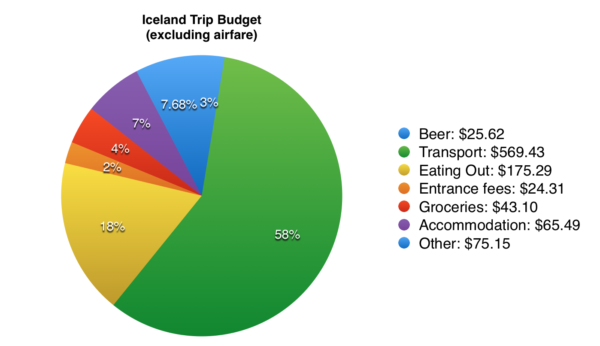
Total Cost for 10-Day Iceland Trip (excluding airfare): $978.38 USD
Detailed Breakdown of Expenses
Transport
My 2WD rental car was $347.28 for three days. I spent $192.61 on gas. (Gas is crazy expensive – $6/gallon!) Now, this also includes the amount of gas I split with my friend when we drove his car. I also paid for a bus to the airport and a ferry to an island in the harbor. I spent $1,050 USD roundtrip on my flight from my home base in Austin, Texas to Iceland. I flew out of Boston to Reykjavk on Iceland Air ($750). I traveled in Boston and NYC after my trip.
Food & Accommodation
I spent $175.29 eating out. I only ate in a few restaurants and hostels in Reykjavik and Akureyri. Most of my meals were premade sandwich’s from cafés and gas stations. Clearly, that’s not ideal, but I wanted to maximize my photography time and didn’t want to waste an hour or more to eat in a proper restaurant. I spent $43 at the grocery store when I could find one. I spent $25 on six beers in 10 days. Five of those beers came from a bottle shop for $4/each. One was $9 in a bar.
Again, since I stayed with my friend, I didn’t spend much on accommodation. Hostels cost on average $40-50 USD, which does NOT include bed linen or towels. Camping is roughly $10-15 a night. Kex Hostel in Reykjavik is really nice, and their breakfast buffet is fantastic. (It’s $4 cheaper if you pre-pay the night before.)
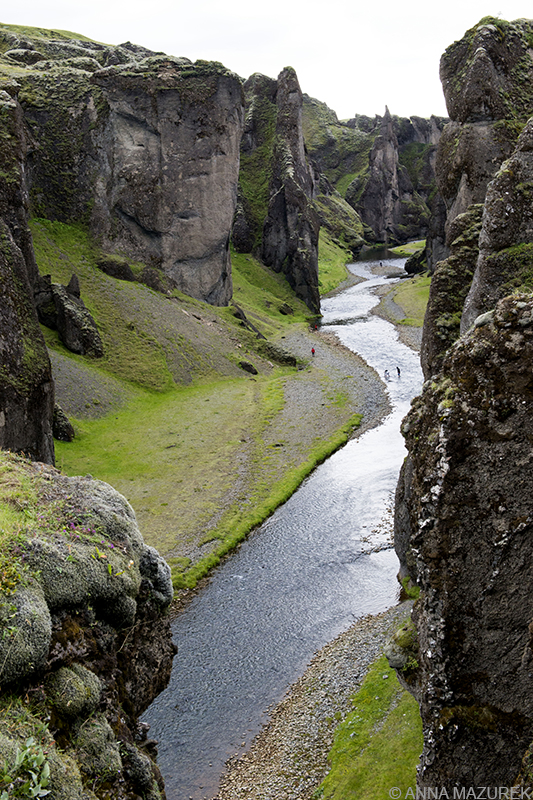
Fjaðrárgljúfur was my favorite spot in Southern Iceland.
When to Go to Iceland
First, decide what you want to see in Iceland, then plan your trip accordingly. The summer is filled with endless sunlight. Sunrise is roughly 4:30 a.m., and sunset is around 11:30 p.m.. The sun never quite sets so the nights look like dusk. In winter, there’s only five hours of sunlight.
Northern lights: September to mid-April
Puffins: April through September
Ice Caves: November to March
Budget Tips
- Reykjavik City Card. This card offers free entry to the majority of the museums and discounts on other attractions. Frees range from $30-47 and have a time limit of 24-72 hours.
- Camp. Hostels cost roughly $40-50/night, and campsites range from $10-15/night. Be warned – some charge outrageous amounts for showers. (Skaftafelt charges roughly $5 USD for five minutes of water!) Unless you have the proper gear, avoid camping in the winter!
- Shower at the public pools. Every city in Iceland has a geothermal public pool, which are awesome to visit. Entry is roughly $6-8, which is cheaper than the showers mentioned above. All pools have gyms and saunas, too! Some even have water slides!
- Sleep in Your Car. I slept in my rental car twice. (I slept in my rental car for four days in Australia driving the Great Ocean Road with friends. Some of the best stories from the trip came from sleeping in the car.) There are gravel lots on all the main roads for scenic viewpoints with plenty of people either camping or sleeping in their cars. Be aware that many main attractions don’t allow this, but smaller lots are no big deal. Again, this is not a good idea in winter.
- Buy Groceries. Cooking at campsites or hostels will save you a good amount. I bought premade sandwiches and yogurt a lot. Skyr yogurt is AMAZING!
- Splurge on breakfast buffets. Many hostels have breakfast buffets with cold cuts and cheese. I made sandwiches to eat later for lunch. Two meals for the price of one!
- Don’t buy food at gas stations. It’s overpriced. Every town will have a grocery store with cheaper prices.
- Pay in the local currency. Many shops will give you the option to pay in your home currency (or USD), but the rate is 5% higher! (Trust me, I did the math!) Always pay in local currency. I had no choice but to pay in Euro for my rental car, which worked out in my favor since I booked far in advance. The rate dropped so I saved about $25!
- Buy alcohol in duty free when you arrive. Beer is $9 in restaurants and $4 for a bottle in a bottle shop. Cut down on your partying or stock up when you arrive! Hostels do have Happy Hour deals where you can buy $4 beers.
- Don’t pay for Wifi. Free wifi is everywhere. Harpa, Reykjavik’s main concert hall, has free Wi-Fi. All the buses for the main tour companies have it. If they are nearby, you can just hop on their network. The entire city of Stykkishólmur has free Wi-Fi by the harbor.
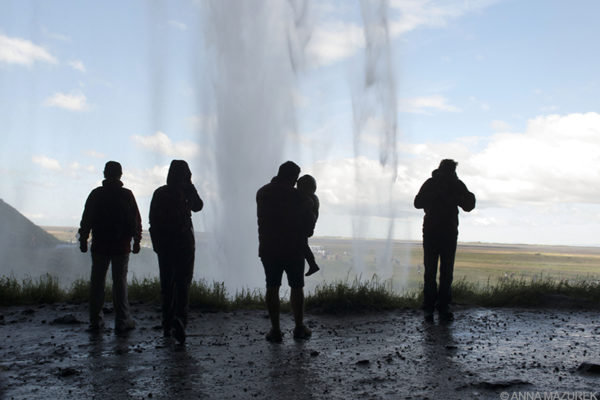
Pack your rain gear if you want to get this view from behind Seljalandsfoss waterfall!
What to Pack
- Snacks. I lined my suitcase with granola bars and packs of nuts. In hindsight, I wish I’d packed some dried fruit!
- Sleeping bag. Bring a warm yet high compact sleeping bag. (I borrowed a friend’s sleeping bag because it was really warm, but it did not pack well.) Hostels charge extra for sheets. Seriously. It’s ridiculous.
- Rain jacket, pants & bag covers. Pack a quality WATERPROOF rain coat and backpack covers. Go buy the $20 rain pants at Academy Sports. (That’s exactly what I did, and they worked well!) Keep a cheap plastic pouch in your bag just in case. I used mine several times to cover me and my backpack, which made it easier to take photos and keep my camera safe. I also use these plastic camera covers for my gear as well.
- Hiking boots. This is the first trip I’ve ever packed hiking boots, and it really helped in the rain and near the waterfalls. (I’m a runner so I always pack my running shoes over hiking boots.)
- Towel. Unless you stay in a hotel, you’ll have to pay to rent one. I’m a big fan of the quick dry towels.
- Camping gear. It’s worth paying to check any extra bag to bring your own gear. It will be cheaper than renting or buying it in Iceland.
- Tripod. If you are going to visit in winter to photograph the northern lights, pack a compact tripod. I didn’t pack one because it was summer. I honestly didn’t really need it.
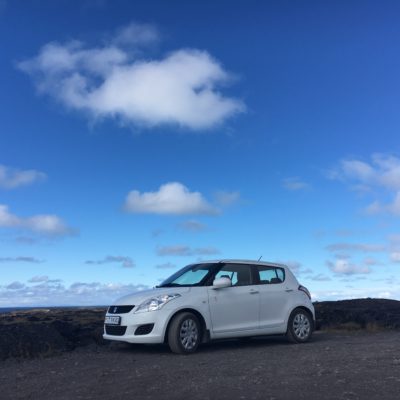
Meet Sophia, my Iceland rental car!
Where to Splurge
Rent a Car
The best way to see Iceland is the drive. There are buses but they they only run once or twice a day. Iceland is probably safest place in the world to hitchhike, but if you’re on a time crunch, don’t risk it.
Since I visited in the summer, I rented a 2WD Suzuki swift, the cheapest option available. I used Route 1 Car Rental. They were great and by far the cheapest in Iceland. Trust me, I agonized over this for ages. They picked me up and dropped me off for free. My biggest tip for Iceland: Get the full insurance coverage for your rental car! It covers gravel, which is crucial since so many cool places are accessible by rough gravel roads. (FYI Americans: Your car insurance will not cover your rental in Iceland!)
Wow Air vs. Iceland Air
Wow Air is a new airline that’s shaking up the budget airline scene with insanely cheap flights to Iceland. There’s a catch – they charge a fortune for all bags based on weight and size. Plus, you only get ONE carryon bag that’s limited by size and weight, which they charge accordingly for. They do NOT allow a second personal item as a carry on. That was the deal breaker for me. I don’t check my camera gear or the gnome. My camera gear would not fit securely in a bag that met their size requirements. Be sure to look up their baggage costs if you are taking your own camping gear. (It was $88 each way to check a bag and have a carry-on bag.) I ended up paying $150 more for the Iceland Air flight, which includes two carry-ons and two free checked bags for free. Iceland Air also offers free stopovers en route to Europe and other destinations, which is a great deal.
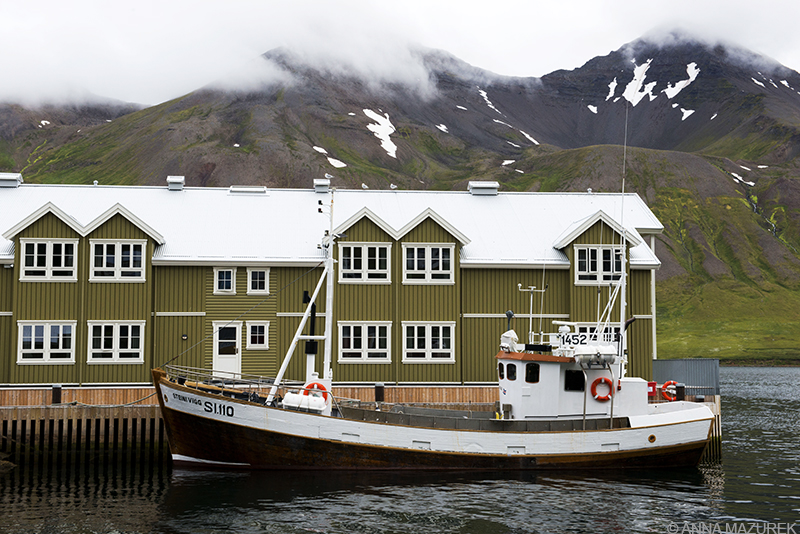
Where to Go in Iceland

Siglufjörður, a remote fishing village in Northern Iceland, has only been accessible by road since 1940.
My country count hit 46 when I stepped off the plane in Iceland. And, it was by far the most beautiful place I’ve ever been!
How could I NOT fall in love with a place filled with stunning waterfalls, glacier lagoons, lava fields, fluffy horses, endless summer sunlight and puffins? That’s right – PUFFINS!!
Iceland has been on my radar since my friend James moved to Reykjavik three years ago. Both the cost and geography kept me away. And, the fact that I was in South America for most of last year. Meanwhile, every photo James posted on Instagram looked like an Iceland tourism ad.
My travels always revolve around the light and stunning scenery. Iceland was no exception. I planned my route solely based on the landscape and light. I choose the summer for the warmer weather and endless light. (The sun never fully sets!)
Here’s a recap of my trip along with the best things to do in Iceland and where to avoid:
Reykjavik
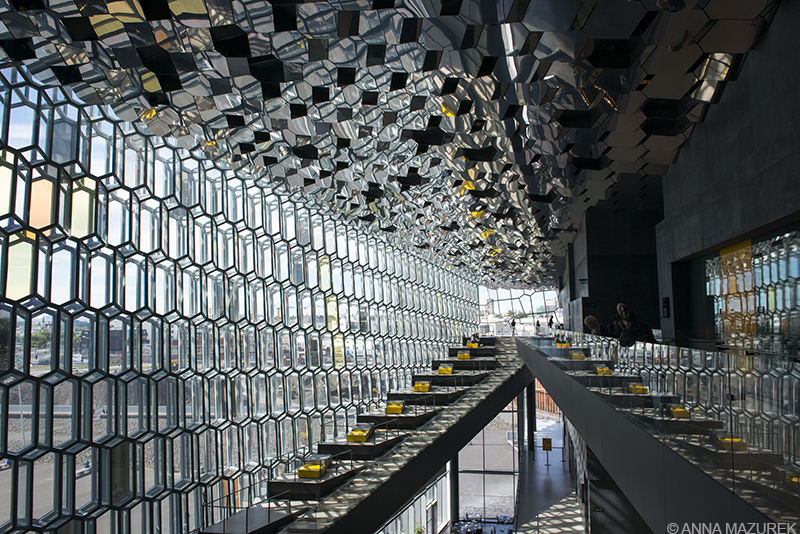
Harpa, Reykjavik’s stunning concert hall, opened in 2011. The building itself is free to the public all day and has free wifi!
I arrived in the capital city of Reykjavik with a heat wave – a sweltering 61°F! Overall, it’s a cute city that’s worth a day or two of exploring. It’s also the the best place for shopping! Harpa, the main concert hall, is gorgeous. I took the elevator to the top of the famous church, Hallgrímskirkja. Since I’m prone to museum fatigue, I skipped most of the museums except for the Museum of Iceland, which was informative. The food was excellent – the fish and chips at Reykjavik Fish was so good I went twice. I took a ferry from Harpa to a small island called Viðey, which is a nice way to spend a few hours.
Southern Iceland
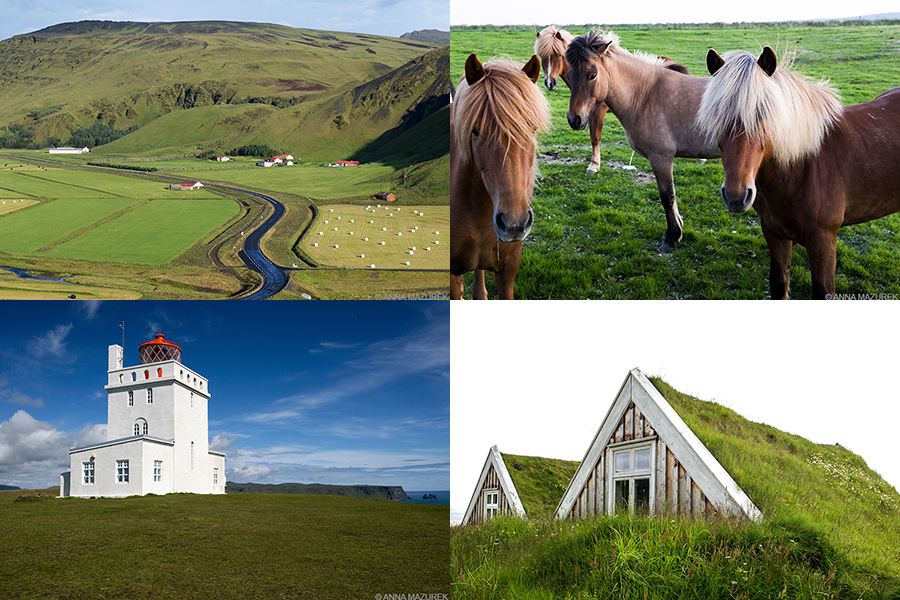
Clockwise from top left: Route 1, Icelandic horses, turf hoses at Sel near Svartifoss and the lighthouse at Dyrhólaey.
Southern Iceland won the scenery jackpot. It is jam packed with the majority of the must-see sites in the country. The best way to explore is to drive Route 1, known as the ring road. The two-lane paved road is an 828-mile loop around the country with a 55 mph speed limit. Who doesn’t love a good road trip?
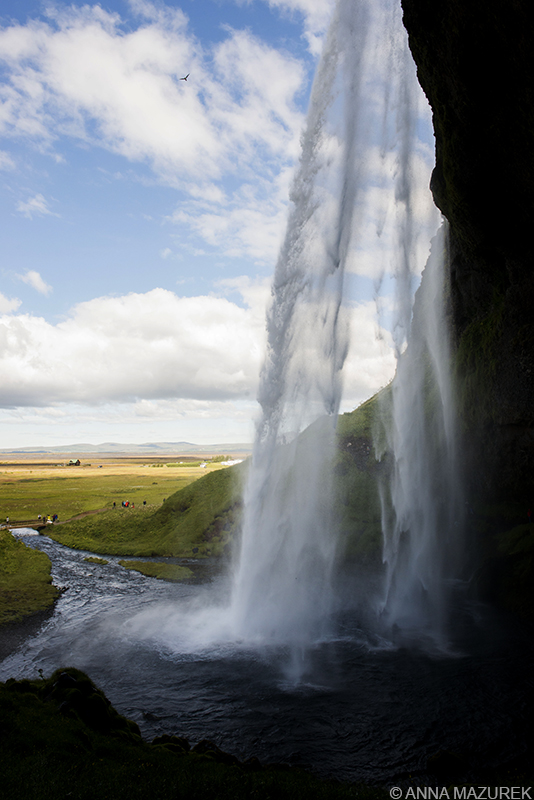
Seljalandsfoss Waterfall, Southern Iceland
My friend James and I headed explored the South in his car. Our first stop was Seljalandsfoss, the famous waterfall that you can walk behind, and the hidden cave waterfall, Gljúfrabúi, next door. Prepare to get wet!
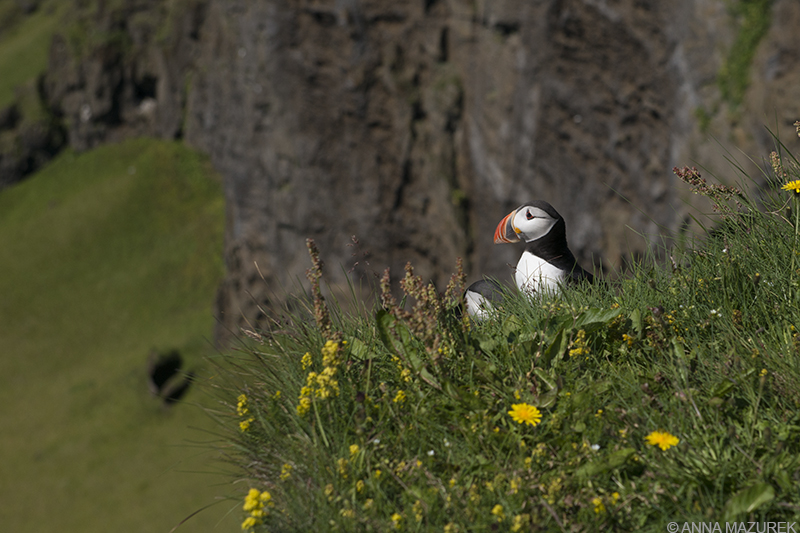
The cliffs at Dyrhólaey were filled with puffins, who frequent the area from April to September.
Our next stop was Dyrhólaey, a set of cliffs with an arch formation. It offers a great view of the black sand beaches and other rock formations. Most importantly, it’s home to a cute lighthouse hotel and PUFFINS. Literally, every cliff was filled with puffins!
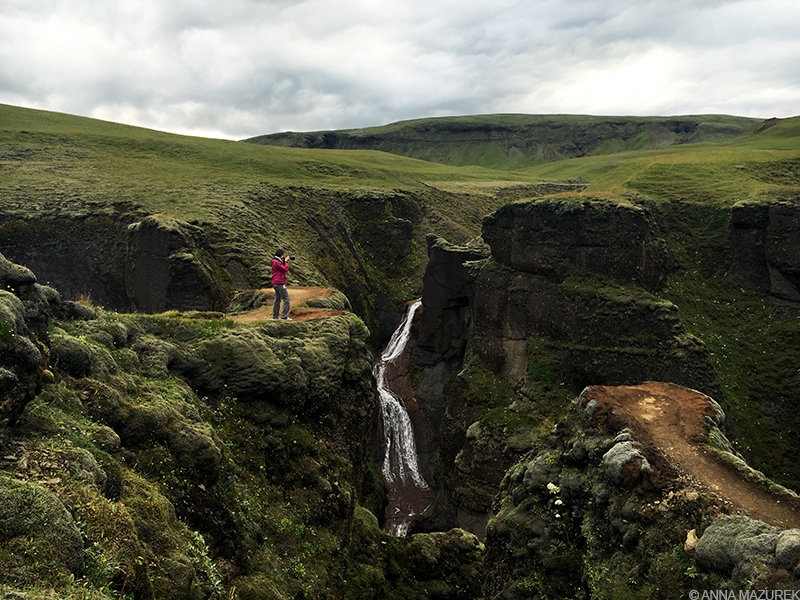
My friend James took this amazing shot of me at Fjaðrárgljúfur, a deep canyon between Vik and Skaftafell.
We stopped in the nearby town of Vik to visit James’ friend who runs a bed and breakfast. She suggested we stop at a 100-meter deep canyon called Fjaðrárgljúfur en route to our campground at Skaftafell. The best part of travel are the little tips from locals – neither James or I had heard of the place. It ended up being one of the most amazing places from my trip and just a short detour off the ring road!
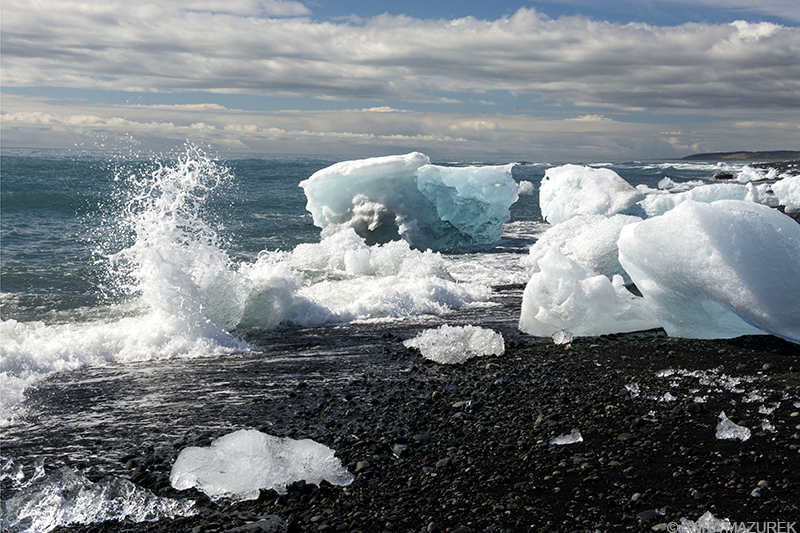
Icebergs wash up on the black pebble beaches near the lagoon at Jökulsárlón.
Jökulsárlón, the glacier lagoon, was phenomenal. I spent a few hours wandering around the lagoon. Be sure to visit the beach on the east side of the bridge for the best photos of mini-icebergs washed up on the shore. Afterwards, we went back to Skaftafell to do the short hike to my favorite waterfall, Svartifoss. The falls are surrounded by basalt columns, dark rock formations created by lava that cooled rapidly. A short hike from the waterfall led to the turf houses at Sel. Turf houses are scattered around the country, but these were my favorite due to the remote setting. (Plus, they were FREE!)
We stopped back in Vik that night to meet James’ friend for dinner. We hung out at her B&B with her guests and staff – a Polish bat expert, an Austrian couple and a French translator. We talked politics and tried rotten shark meat, an Icelandic delicacy. (It tastes better than it smells!) Since it was pouring rain that night, we couldn’t be bothered to put up our tent so we slept in the car. (The best road trips always involve sleeping in cars!)
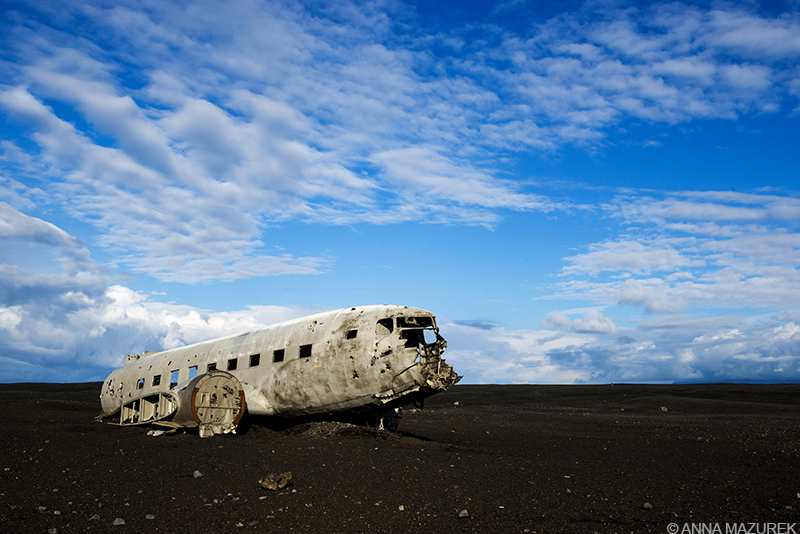
The famous wreck of an old plane near Vik is no longer accessible by car so be prepared to walk!
To avoid crowds, we got up at sunrise to hike to the eerie wreckage from the U.S. Navy DC plane that crashed in 1973. (Everyone survived!) The site is a 4 km walk from the main road on Sólheimasandur beach near Vik. (GPS: 63°27‘32.8“N 19°21‘53.2“W) There’s no sign on the main road, but there is usually a large amount of cars parked at the entrance to the path. Afterwards, we stopped by Skógafoss that afternoon. The waterfall is stunning, and you can usually see a rainbow in the mist. The hike to the top is worth it!
Golden Circle
I borrowed James’ car one day and went to the Golden Circle, which is made of three spots – shooting geysers (surrounded by crowds of people), Gullfloss waterfall and a Þingvellir National Park, home of Iceland’s first parliament. All sites were super touristy and not as exciting as everything I’d seen in the South. Skip the Golden Circle and spend more time driving the ring road!
Snæfellsnes
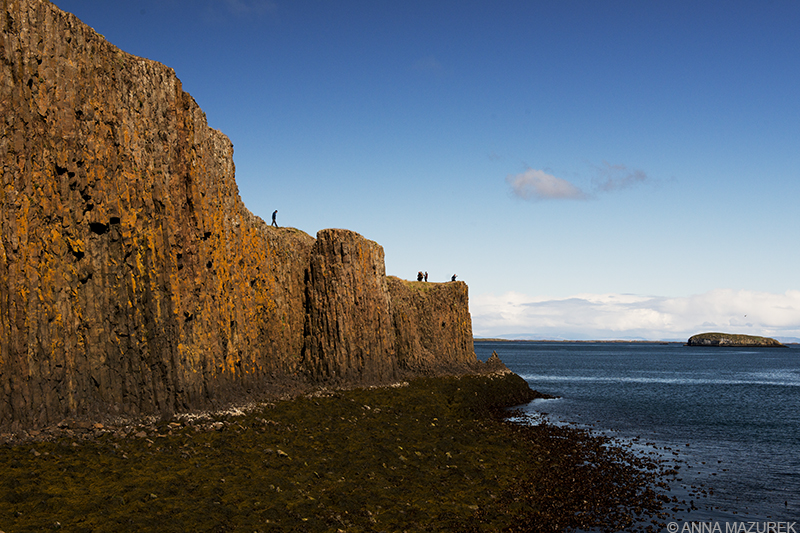
The basalt island of Súgandisey offers a great view across Stykkishólmur harbor and Breiðafjörður.
I rented a car – a 2WD Suzuki Swift hatchback that I named Sophia— the next day and headed north to explore Snæfellsnes solo. The 90km long peninsula was my favorite part of Iceland because it was packed with stunning landscapes. My first stop was Stykkishólmur, a quaint harbor town with a stone causeway linking the town to a basalt island (above) topped with a scenic lighthouse. The entire town has free wifi, and Nesbrauð, a budget-friendly bakery on the edge of town has excellent pastries and sandwiches!
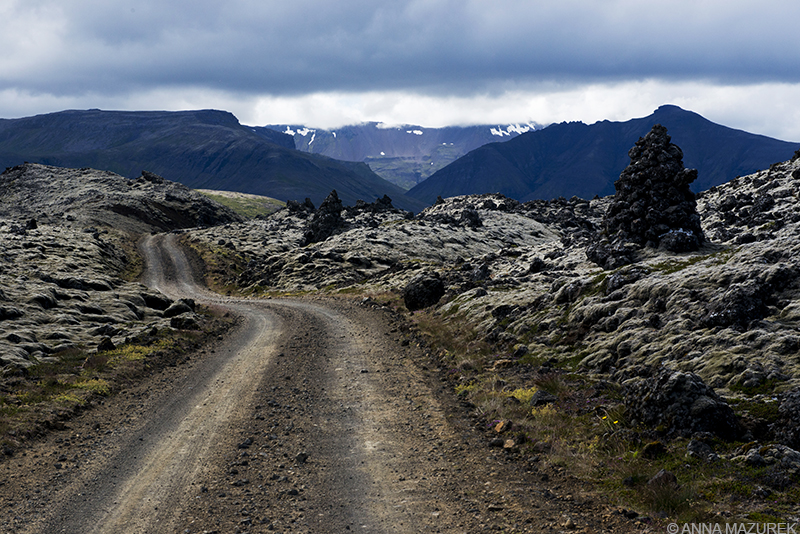
A four-wheel drive vehicle is not needed to drive the dirt road through Berserkjahraun Lava field .
A drive through the moss-covered Berserkjahraun lava field is a must. A dirt road winds through the lunar-like landscape formed by ancient lava dating back 3,000 years. The turn off to the loop road is on Route 54 just passed the intersection with Route 56. The sign is tiny and easy to miss.
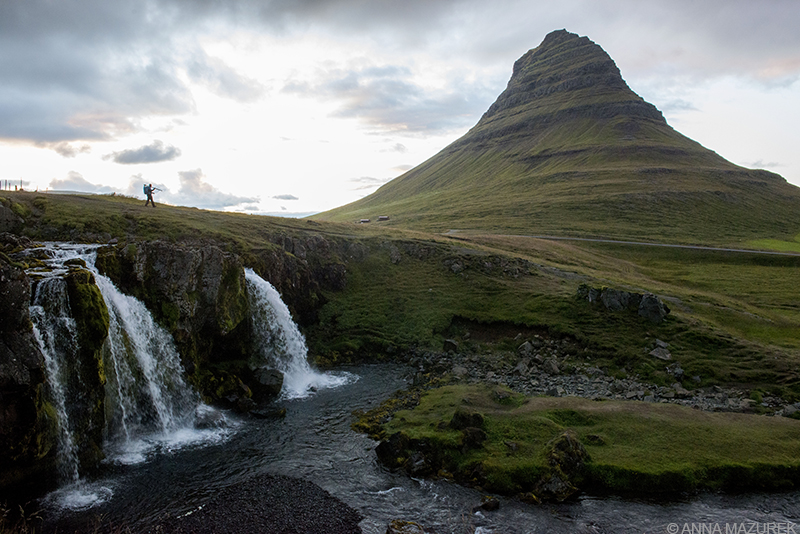
A photographer walks back to his car at Kirkjufell at sunset, which is roughly 11:30 p.m. in the summer.
You can’t miss Kirkjufell – it’s lush green peak makes it the most photographed mountain in Iceland. It juts out to sea on the edge of the town of Grundarfjörður. It’s stunning at any time of day. I photographed it three times – the first time in the afternoon, again at sunset around 11:30 p.m., then slept in my rental car so I could photograph it again at 5:30 a.m.!
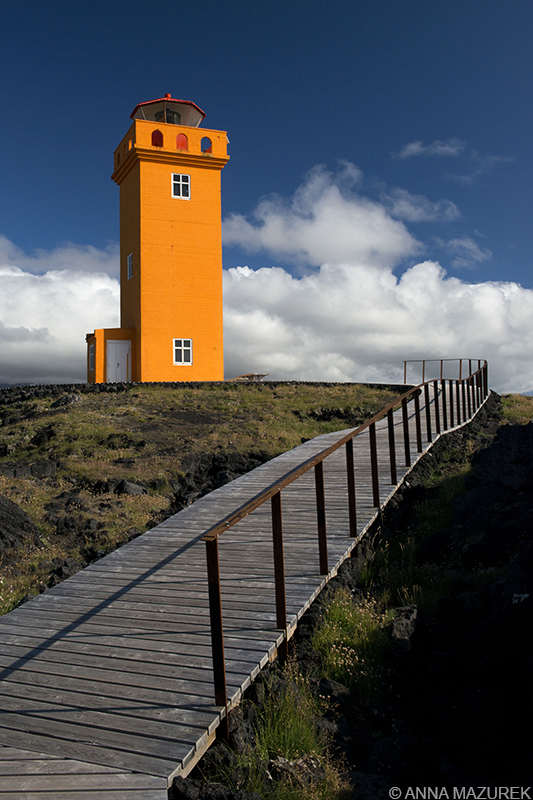
Svörtuloft Lighthouse in Snaefellsjokull National Park
Iceland’s first national park, Snaefellsjokull National Park, encompasses the far West end of the peninsula including a gorgeous stretch of rugged coast line, a volcano and glacier. One of my favorite scenic drives was the gravel Route 579 at the north edge of the park. The dead-end T-shaped road leads to two colorful lighthouses on each end with scenic cliff views.
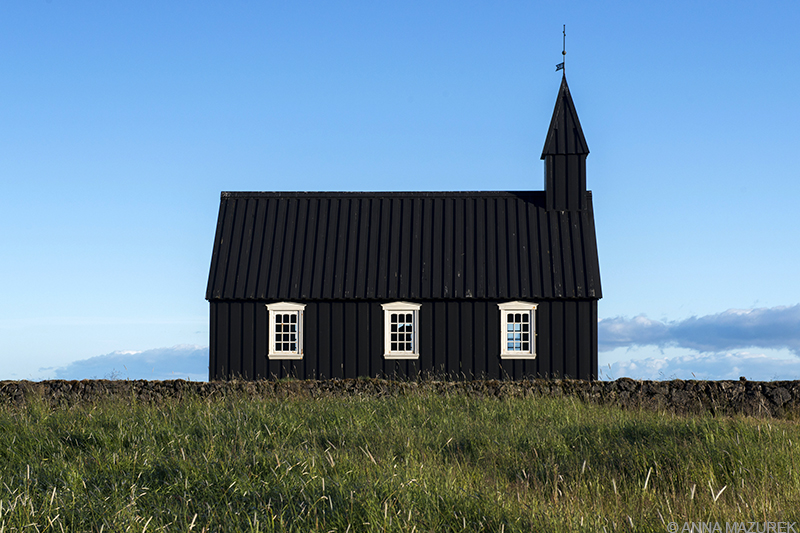
The black wooden church at Búðir was built between 1984-6 and is a replica of the original 1703 church.
Other park highlights were Djupalonssandur, a peddled beach scattered with the remains of a 1948 shipwreck, and Búðir, an barren lava field that’s home to a four-star hotel and a photogenic black church.
Northern Iceland
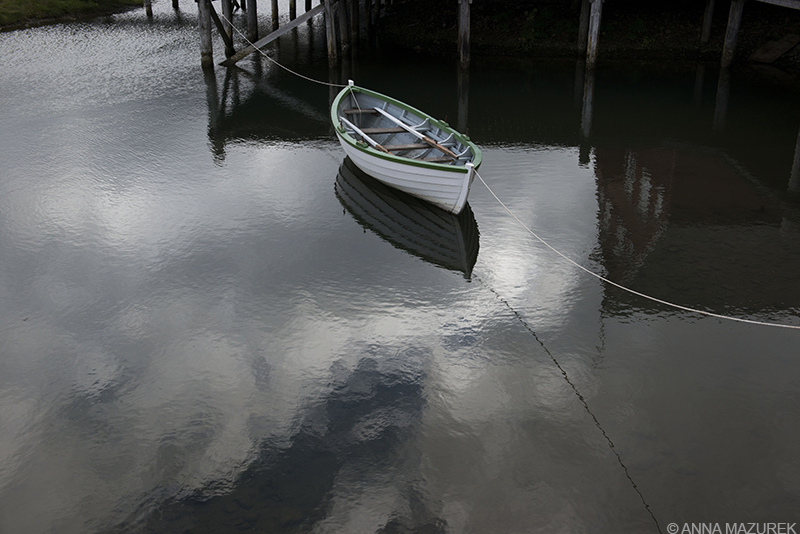
Siglufjörður
In the North, I took a detour off the ring road to drive around the Trollaskagi Pennsuila, which was one of my favorite drives. I stopped in the small, cute town of Hólar, the former capital of North Iceland. The center of town is home to oldest stone church in the country and cute turf houses.
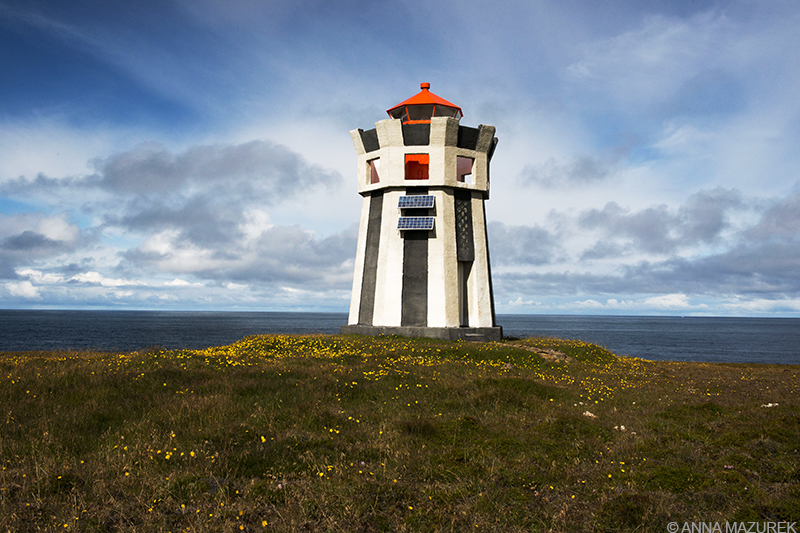
Straumnes lighthouse near Hofsos, Iceland
Since I’m obsessed with lighthouses, I was determined to find the isolated Straumnes lighthouse (above), which is located on a remote cliff north of Hofsos. Since Google was no help, I emailed the local museum. The director informed me that the roads were too bad for my 2WD-drive rental car, and he volunteered to take me in his 4WD truck! Everyone in Iceland is incredibly friendly and helpful. Anytime I needed help finding a remote location to photograph, I emailed the local tourism board or museum who always provided excellent directions. The lighthouse was located 3km down a rough dirt road on a farm that lies on the edge of a cliff about a 15-minute drive north of the village. During the drive, the museum director mentioned that as a child, he thought every country could see the northern lights! I totally wish I could have seen the northern lights as a kid on my parent’s South Carolina farm!
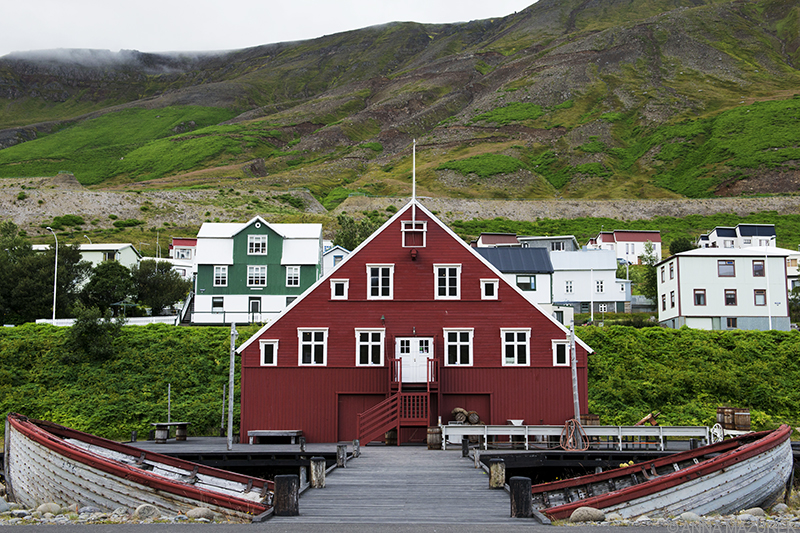
The Herring Era Museum consists of three picturesque buildings along the Siglufjörður harbor.
The most stunning village in Iceland is Siglufjörður, a small fishing village located in a scenic fjord accessible only by two scary one-lane tunnels with two-way traffic. (Seriously, it was the longest three kilometers of my life!) The town is home to the award-winning Herring Era Museum, which pays tribute to the town’s role at the epicenter of Iceland’s herring fishing industry. I only visited part of the museum and loved it!
I spent a night in Akureyri, Iceland’s second largest city, before driving to Lake Mývatn and Dettifoss, Europe’s most powerful waterfall. Dettifoss is accessible by a paved road, Route 862, for non-4WD vehicles. Go before 10 a.m. to avoid the tour bus crowds!
Blue Lagoon
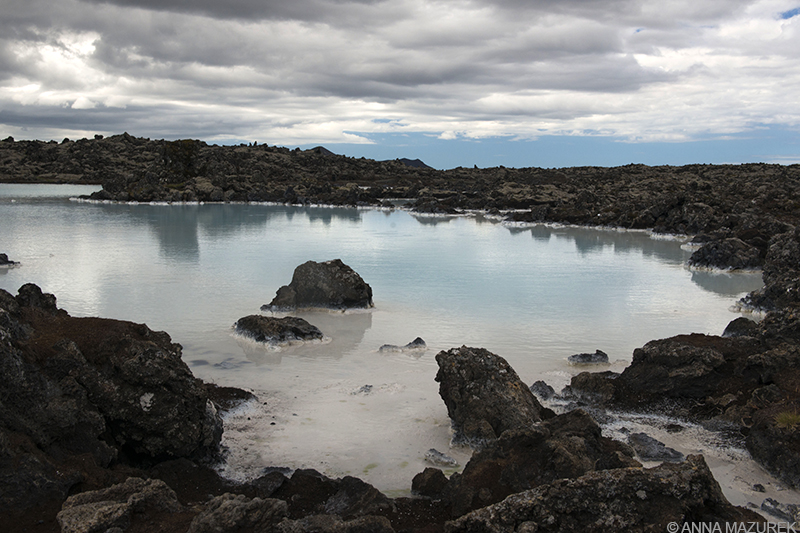
The pools outside the entrance of the Blue Lagoon are more photogenic than the lagoon itself!
I spent my last day in Iceland at the Blue Lagoon, a man-made geothermal spa located in a lava field not far from the airport. I honestly thought it was overpriced and overrated. Plus, the construction cranes and power plant in the background killed the view. The deserted pools outside the entrance were the most photogenic. I much preferred the geothermal public pools I’d visited on my trip. Every city in Iceland has a pool with a gym and a variety of different pool types and temperatures. (Entry is $6-8 USD.) My favorite one in Borg had a huge water slide! (No photos are allowed at public pools so I couldn’t shoot the water slide.)
Overall, I spent 10 days in Iceland and wish I had more time. I plan to go back during the winter months to photograph the northern lights and ice caves. You can never see it all in one trip! My only regret is not visiting Iceland sooner! What are you waiting for?!?
___________________________________________
COMING UP:
Budget Tips for Iceland
In the final part of my Iceland series, I breakdown my trip expenses along with budget and packing tips. As a bonus, I’ll share a few secrets for photographing Iceland’s top sites!
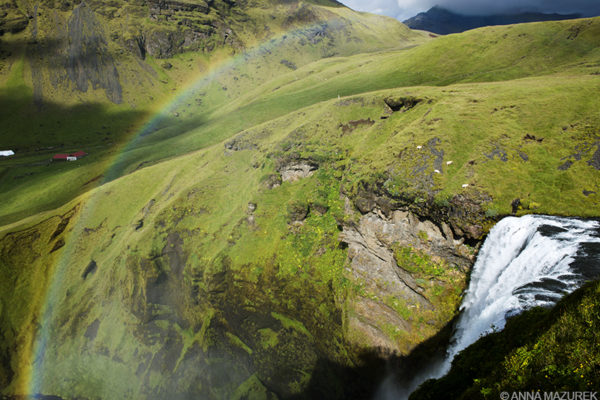
Skógafoss Waterfall
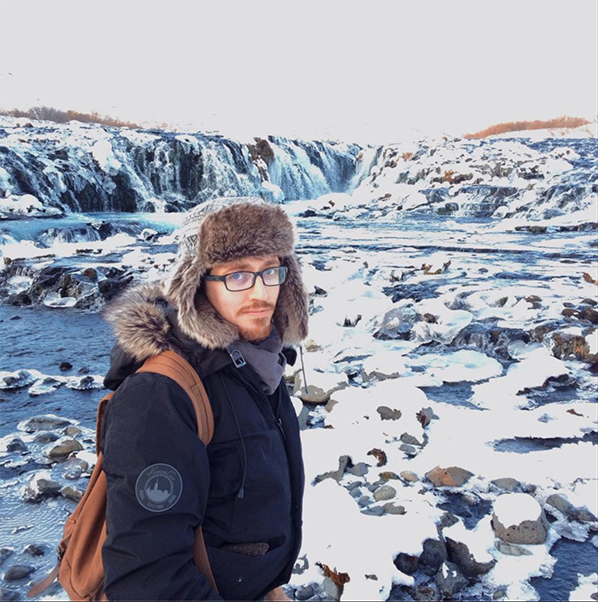
Interview with an Iceland Expert

I went to Iceland to visit my old friend James McDaniel, an expat who’s been living in Iceland for over three years. We worked together in Birmingham, Alabama for a few years, and both quit our jobs to work in Asia in 2012. In August, we road tripped through Southern Iceland together, and I picked his brain for Iceland tips to share with you!

James McDaniel’s favorite place in Iceland is Brúarfoss, a hidden waterfall that’s not visible from the road.
Name: James McDaniel
Age: 29
Hometown: Birmingham, Alabama
Country Count: 18
1. How did you start traveling? Tell us how you ended up in Iceland.
My first big independent trip was to study Mandarin Chinese in the People’s Republic of China when I was about 17. I’d say growing up my parents always inspired a deep sense of curiosity of other places and cultures in me and my brothers. Having a network of supportive family and friends definitely can be encouraging but also makes you long for home when you’re on the road. Oddly enough, I ended up in Iceland after working in China for a summer back in 2012. Let’s just say I stumbled upon the island mostly by accident while taking the long way back to my home state of Alabama, fell in love and ended up moving to Reykjavik soon after.
2. What are your favorite places to visit in Iceland? Share one of your favorite Iceland memories.
One of my favorite places to visit is the rather off-the-beaten-trail waterfall of Brúarfoss. It’s glacial cerulean blue waters are captivating any time of year. One of my favorite Icelandic memories though was when my husband took me to a surprise concert by one of my favorite Icelandic singers Ólöf Arnalds. It was a small concert of about 30 people held in the rare books room at the National Archives in Reykjavik, so intimate and romantic. For a country as small as Iceland with such a little population, it’s amazing how many world class musicians, artists and athletes they produce.
Must see places in Iceland: the glacial lagoon (Jökulsárlón) and Stykkishólmur in Snæfellsnes. I’m impartial to this little seaside town [Stykkishólmur] in the Snæfellsnes Peninsula as I spent my honeymoon there in 2013. More than lovely.
3. When is the best time to visit Iceland?
Every time has something different. Most people tend to prefer summer, but I have a bit of morbid sensibility that has me drawn to that arctic darkness of late winter, howling winds and northern lights. It can be a bit spooky, but I kinda like that.
4. Share a few tips about how to cut cost on traveling in Iceland.
Iceland is one of the most expensive countries to visit in the world. Seriously. After living here for three years now, when I leave, everything feels less expensive than here in Iceland. I’d say take some time to look up places to eat and stay. Unfortunately, as tourism has increased so has the inevitable tourist trap or two. Don’t be surprised if a roadside dive is charging US $20+ for a burger. If you’re on a tight budget, stick to buying food at the grocery store.
Other cost saving tips: camp, don’t drink [beer is $9 in a bar!], bring some snacks, attend some anarchist ‘food not bombs’ meet ups for some free food and deep conversation.
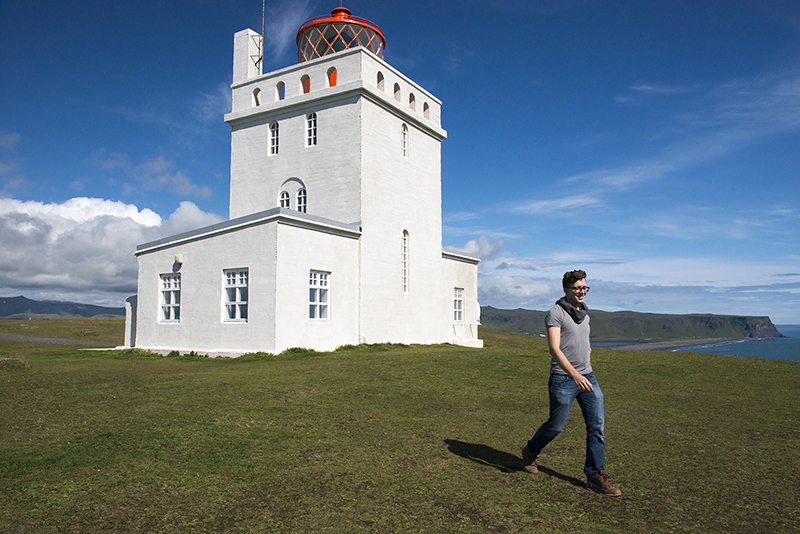
James and I stopped at Dyrholaey near Vik for photos and to see puffins our road trip through the Southern part of Iceland.
5. What’s the best place to see puffins/horses/sheep, etc.?
Puffins are seasonal [April-Sept.] and nest at certain places on the coast like in the cliffs in the south near Vík. Horses and sheep are just about everywhere. In fact, if you are driving, be especially careful to keep an eye out for sheep. They may stray onto the road. All the sheep in Iceland are free range, and though, they are usually fenced off from the roads, they have the right of way.
6. What are three things everyone should pack for Iceland?
Rain pants, raincoat, waterproof boots. That’s just to say, rough weather is a possibility, but it doesn’t have to ruin your trip if you stay dry!
7. What is the best form of transport to get around Iceland?
Rent a car. You can take a few public buses to some places, but service is limited and mostly runs just twice a day outside of the capital area. There are no trains, but there is a domestic airline that flies to different parts of Iceland, Greenland, and the Faroe Islands, but it’s prohibitively expensive for most travelers.
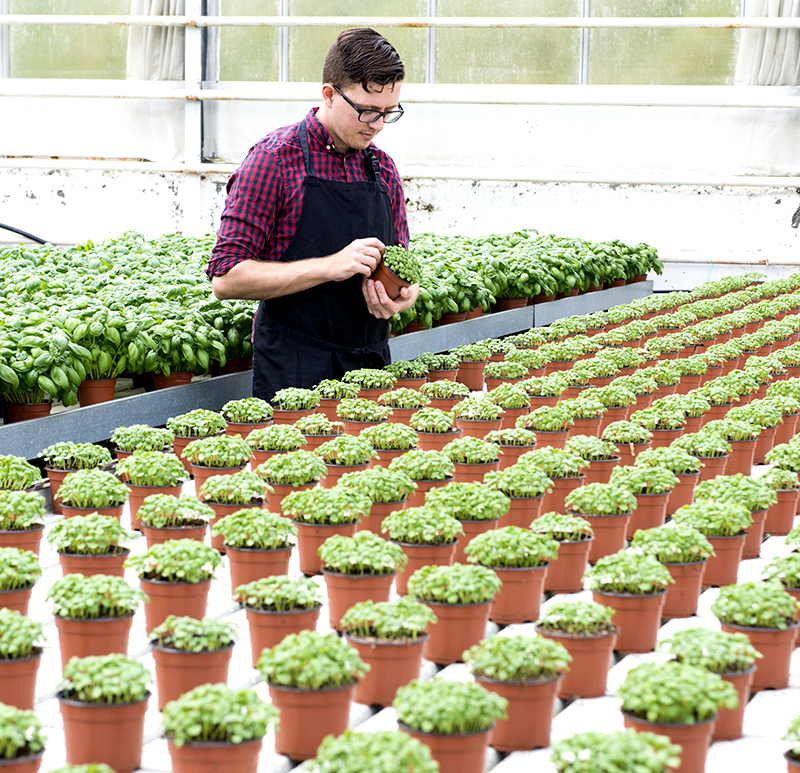
James works at a greenhouse near Selfoss, Iceland that specializes in culinary herbs and a variety of flowers.
8. What advice would you have for aspiring travelers regardless of their destination? Any tips for overcoming fear?
Don’t be a tourist. Yes, you’re on holiday. You’re on vacation and should be having fun, but please try to learn something about where you’re going and what shaped the land, people and culture. For example, take a minute to read up on Iceland’s rather rough and grim history as a Danish colony and their struggle for independence. Look up a bit of the woman’s rights and LGBTQI+ movement here and how Iceland has always pushed farther ahead of any other country to be more inclusive. But, at the same time, maybe read up on some of the current issues facing the people living and trying to live on the island like the Iraqi refugee hunger strikes and Syrian asylum seeker deportations. Any place that presents itself as a utopia is trying to sell you something, dig a little deeper, see what flaws and strengths connect us as humans, don’t be afraid to ask tough questions.
9. Can you share any safety tips or things to avoid in Iceland?
Don’t wander into the wilderness; it could kill you. Every year, we lose tourists to the harsh natural environment that makes this place so special. Take weather warnings and road conditions seriously. Icelanders are tough as nails, so if cars are turning back at an icy road, don’t forge ahead. Be prepared for rapid and drastic changes in weather, always have some extra layers as even in the summer you might get a sudden cold wind down from the arctic.
10. What’s your next adventure?
Well, as I write this I’m finally making it over to visit Bristol, UK. Lovely and incredibly green. More longterm, a friend and I are cooking up a trip north to Greenland.
___________________________________________
COMING UP:
A Photo Guide to Iceland: Where to Go & Budget Tips
Next week, I start a two-part series on Iceland. The first part will focus on a photo tour of Iceland and the best places to visit. The second part will dive into budget tips for traveling in Iceland including a detailed breakdown of my trip expenses!
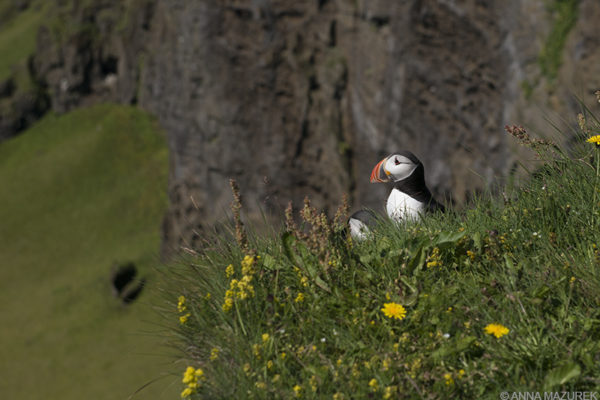
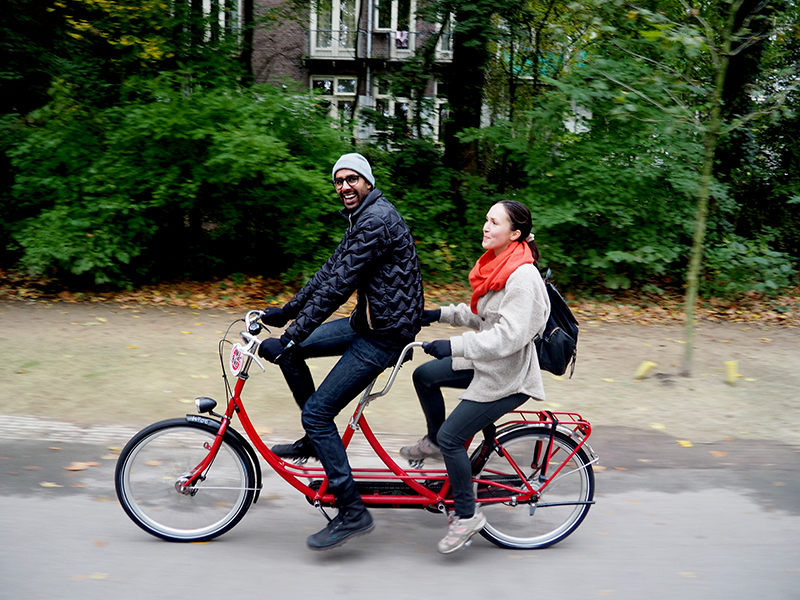
The Art of Couchsurfing

Nishant Prasad has spent five of the past eight years couchsurfing around the world. He has utilized the hospitality and social networking website Couchsurfing.com to arrange free accommodation and meet a lot of amazing people including his fiancé Isabelle. Nishant inspired me to start couchsurfing after we worked in India together running community service trips a few summers ago! Now, it’s time for him to inspire you to do the same!

Nishant Prasad and his fiancé, Isabelle St-Germain, went biking around Amsterdam as part of their two year trip couchsurfing around the world! They stopped in Europe before heading to Asia. (All photographs courtesy of Nishant Prasad)
Name: Nishant Prasad
Age: 29
Hometown: Suva, Fiji & Seattle, USA
Country count: Somewhere around 75
Blog/Website: www.WTFnishant.com
Instagram: TallCupOfChocolateMilk
1. How did you start traveling?
When I was 21, I was a bit exhausted with life. School, work, blah, blah, boredom. Around this time, my uncle was visiting Seattle from Australia. On his way out, he mentioned that I should visit him and my cousins, who I had not seen in over 10 years. A few weeks passed. On the drive home after a late shift at work, [I] decided that I would take him up on his offer. I filled out a visa application online, entered in my credit card details, hit submit and then, went to sleep. The next morning, I woke up to an email stating that I had three months to enter Australia. I said bye to the life I knew, packed up and left. Since then, I have been hooked on seeing everything that this world has to offer. Five out of the last eight years have been spent on the road.
2. How did you get into couchsurfing? [Couchsurfing.com is a hospitality exchange website with an extensive social network. It’s basically a free version of Airbnb that’s based on a peer review system. The community also hosts weekly meetup events around the world.]
Shortly after I arrived to Australia, I moved to Brisbane. I got a part-time job, a place to stay and started to explore the new life I now had. I met a German girl by the name of Pia somewhere in town, and she invited me out to a couchsurfing meetup at a bar. Prior to this, I knew nothing about couchsurfing, but none the less, I was keen to meet new people. Turned out that this was one of those life changing events. Eight years later, I have surfed many couches, had many surfers stay with me and organized events all over the world.
3. What is the biggest myth about couchsurfing? Share some safety tips for finding a good host.
Everybody is out to get you, and they just want to take what is yours. In reality, it’s the opposite. The world is filled with amazing people; you just have to meet them.
Safety wise, the reference system on the website is your best friend. If 83 people have nothing but good things to say about your potential host, chances are that he or she would be pretty awesome. Try to stay with more established members and stray form the ones that have negative references. Besides that, you have to go with your instinct. You are not entitled to stay with or host anyone. Keep the phone numbers and addresses of a few hostels nearby just in case.
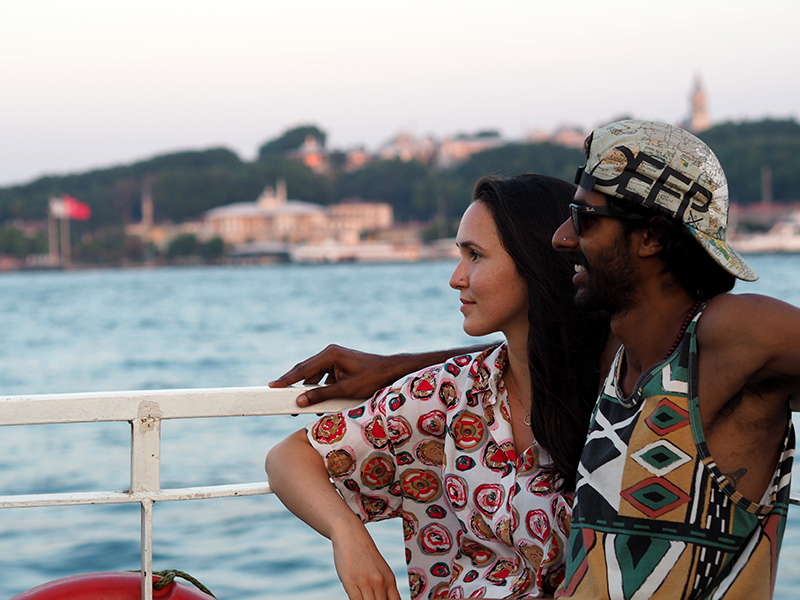
Nishant and his fiancé, Isabelle, stopped in Istanbul, Turkey on their two year round-the-world trip to celebrate their engagement.
4. Did you meet your fiancé through couchsurfing?
I met Isabelle as a result of Couchsurfing. While I was living in Brisbane, I had some French Canadians crashing at my place for a week or two. During this short period, we became good friends, but we were split apart a few months later due to different travel plans. Years passed and we kept in touch but because of the distance, we had not met since. I finally made my way up to Montreal about four years later, and we had our long awaited reunion. Isabelle happened to be good friends with one of them and that’s how the love connection was made.
5. How did you fund your travels? What is your normal budget?
Every so often, I return back to Seattle to make money. I have been very fortunate to work for an amazing company that always finds a position for me when I am around. It’s a big plus when your boss is on board with your personal enrichment!
Working abroad is not always feasible due to visa restrictions in many countries. But, there are a lot of amazing websites like HelpX, Wwoof and WorkAway that link you with volunteer opportunities all around the globe. In many instances, room and meals are offered in exchange for your help.
Planning for the next trip starts years in advance. At this point, the next two major trips are already in the works. Now to learn Spanish and collect more money!
As for budget, we don’t really have one. We just try not to go overboard with our daily spending and that tends to keep prices down. It’s just deciding what your needs are over your wants. Pretty much the same thing we would do while we are back home. With that said, for the most part, we spend less daily while on travels than at home. Most days are under $20 USD per person per day. Usually less in most instances. It’s just limiting yourself to seafood dinners when you are in a cheaper coastal town. Deciding when you deserve a beer, etc.
6. Tell us about your most recent adventure.
The most recent adventure started about two years ago when I proposed to my now fiancé in Montreal. The next day we embarked on our next world trip by flying to Paris. We spent the last two years making our way around Western Europe, The Balkans, North Africa, the Caucasus region, The Gulf, India and Southeast Asia. We just arrived to New Zealand a month ago where we plan to travel and volunteer around the country.
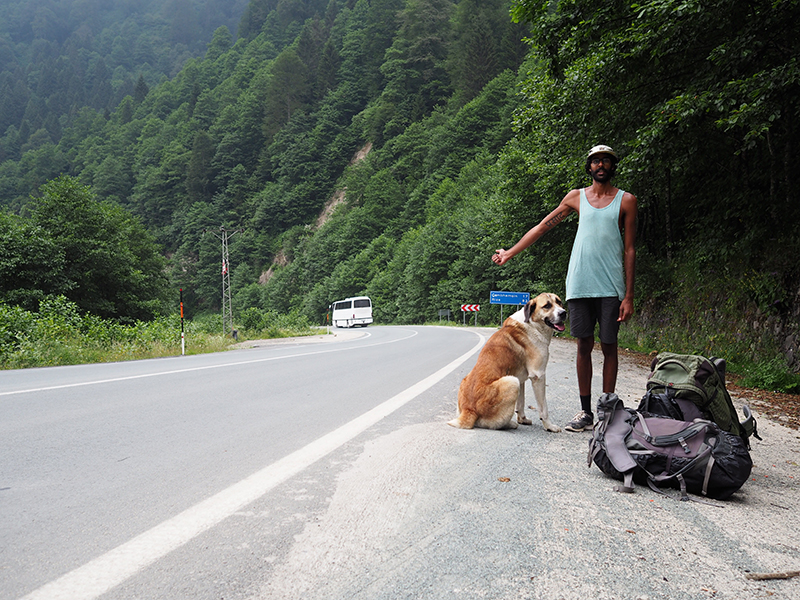
Nishant Prasad hitchhiked and couchsurfed his way across Georgia and Armenia in Eastern Europe last year.
7. Share one of your travel highlights.
While we were traveling through Turkey, Cyprus, Georgia and Armenia for a few months last year, we decided to make our way around solely by hitchhiking. The level on kindness of the people in this part of the world is unparalleled. Even though we could barely communicate with the language difference, people went out of their way to show their amazing hospitality. Something we will remember forever.
All in all, I must have couchsurfed over a hundred times in about 30 countries since I joined Couchsurfing.com. About a third of these have been with members who had stayed with me previously or who I had met on travels. It really is a network that goes full circle. A bulk of the people I have met still remain good friends to this day.
8. What advice would you have for aspiring travelers? Any tips for overcoming fear or budgeting?
It is very, very, very easy to get comfortable. You can have a good job, a nice apartment, a close knit group of friends and such. To this day, I still struggle to leave after settling down for a bit. But once you leave, and step out of your comfort zone, you will be rewarded past anything you may know.
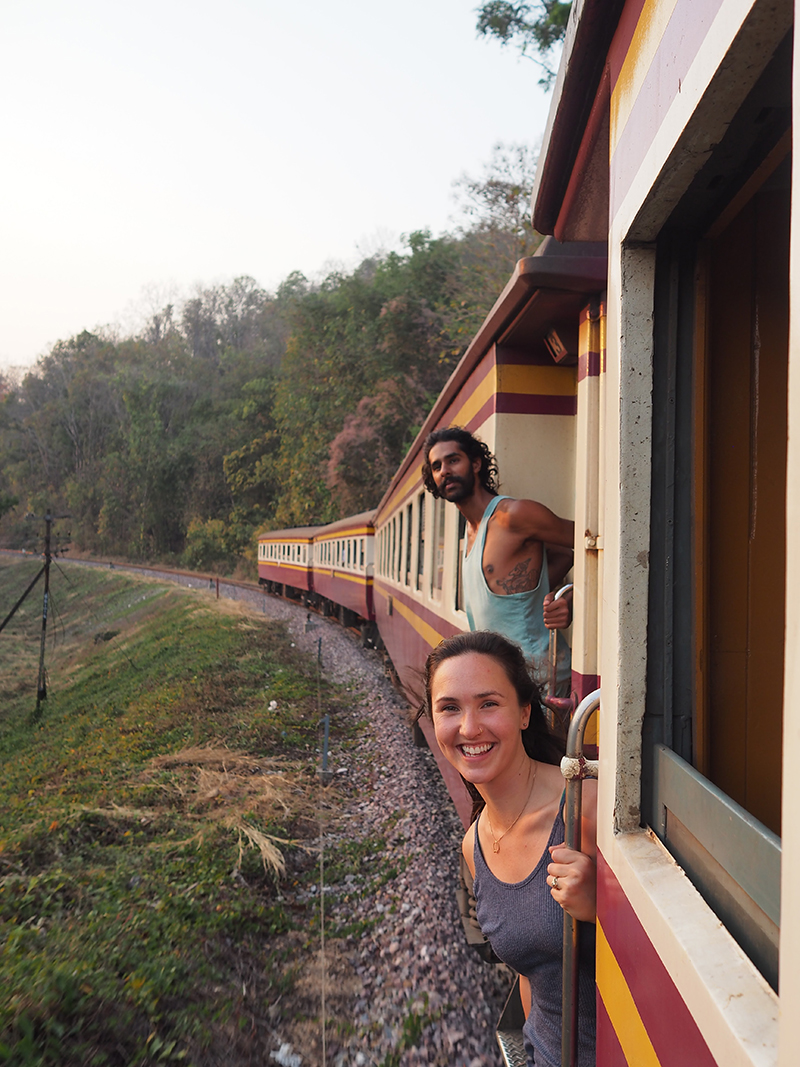
Isabelle and Nishant travel on the Chiang Mai Express in Thailand. The couple roughly spends $20/USD a day on the road.
9. Name three things you always pack for a trip.
- Smartphones with the aid of offline maps have revolutionized travel for me. As fun as it is to get lost, it’s also nice not to wander around with a heavy pack.
- Compression sacks, best thing for packing. Makes it super easy to fit everything into a backpack; though, the downside is that you end up with wrinkly clothes sometimes.
- Oh, and you can’t forget the passport!
10. What is your next adventure?
The next big trip will be in Mexico, Central and South America. Need to get my Spanish to par first!
________________________________________
Interested in Couchsurfing?
Check out the Couchsurfing.com website to find out more! Attend one of the free meetups to meet local members and ease your fears. Nishant inspired me to couchsurf, which is how I met Kaleena Quarles, who I interviewed recently about funding her solo round the world trip by teaching English in Korea!
For more information, check out my Guide to Working Abroad and tips for saving on accommodation!
_______________________________________
Come with me to
I C E L A N D!
Next week, I head to Iceland for one of the most exciting (and expensive) trips of my life! I’ll be taking a two week break from the blog BUT promise to have a detailed report of my trip including costs and tips for planning your own Iceland adventure when I get back! The best part is you can join me on my trip via Instagram!
P.S. Let me know what Iceland questions you have in the comments below!
